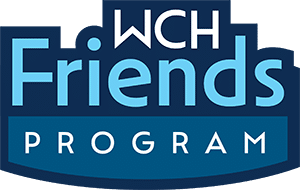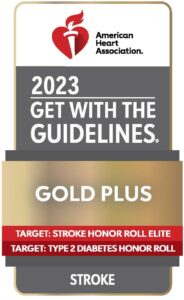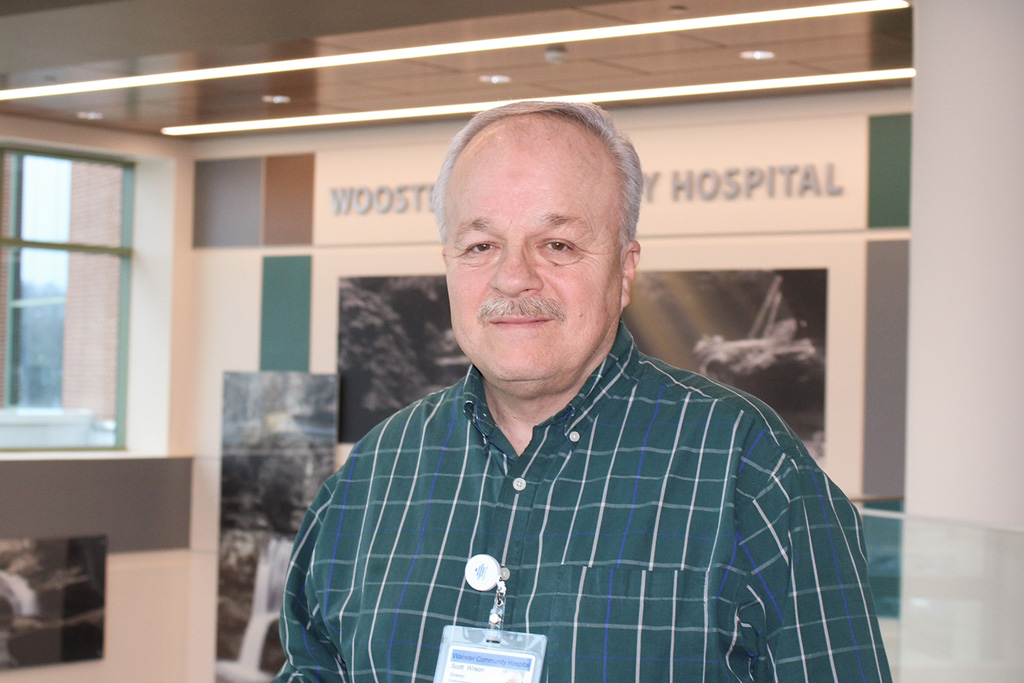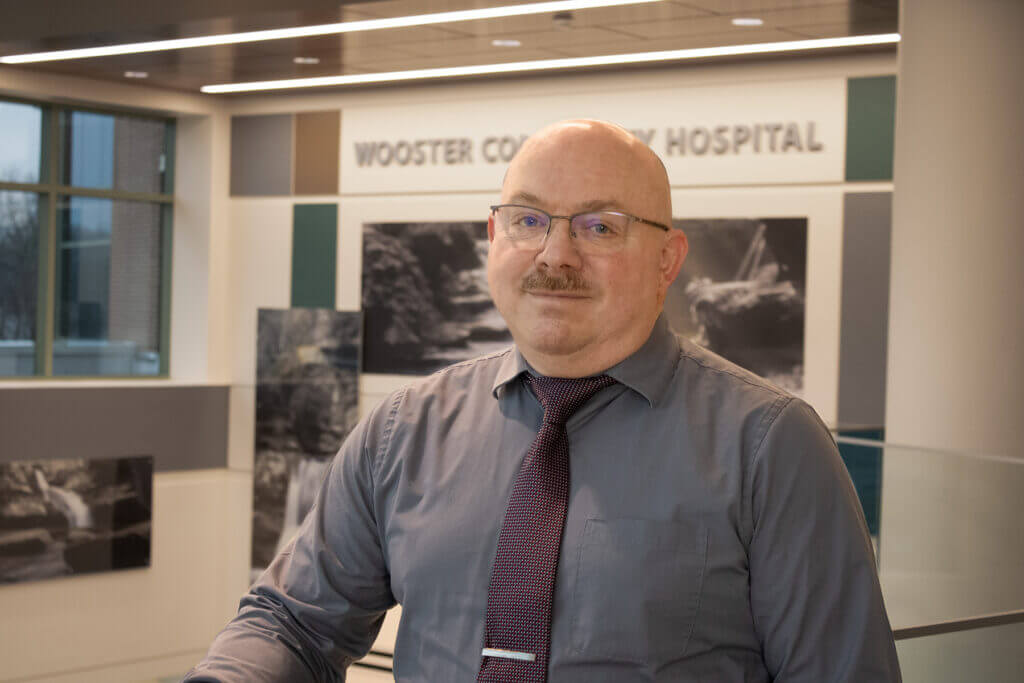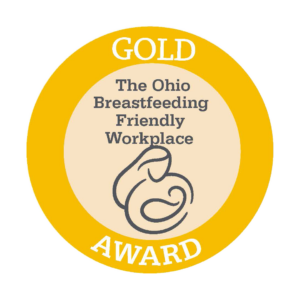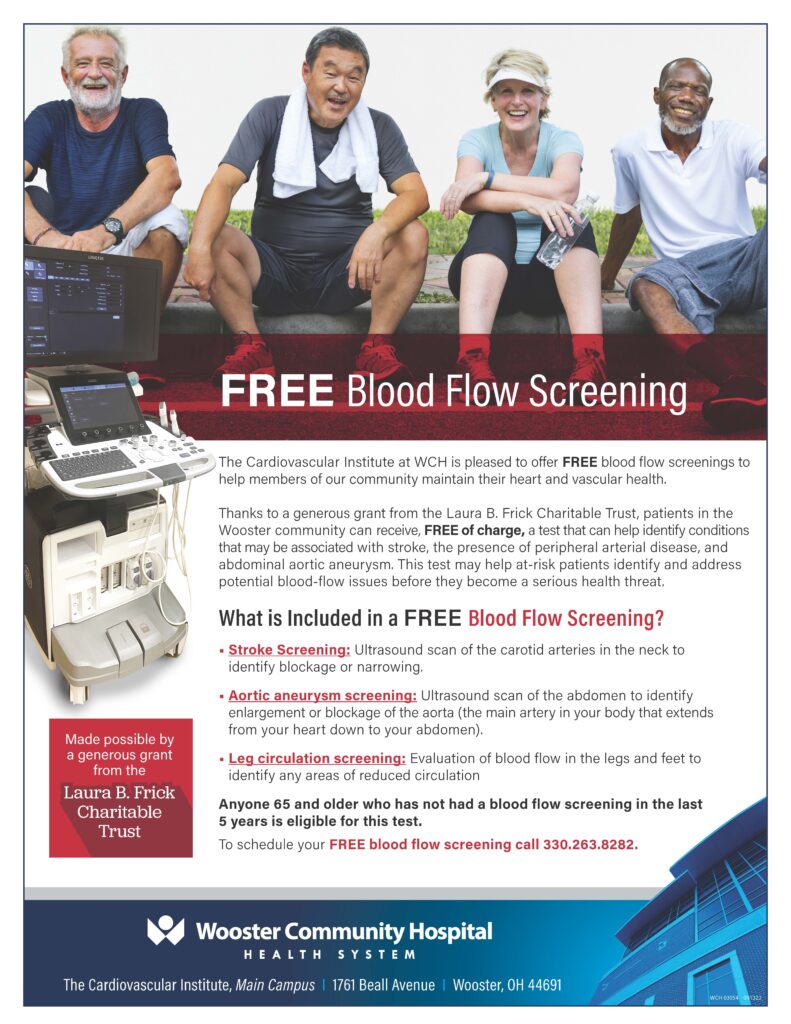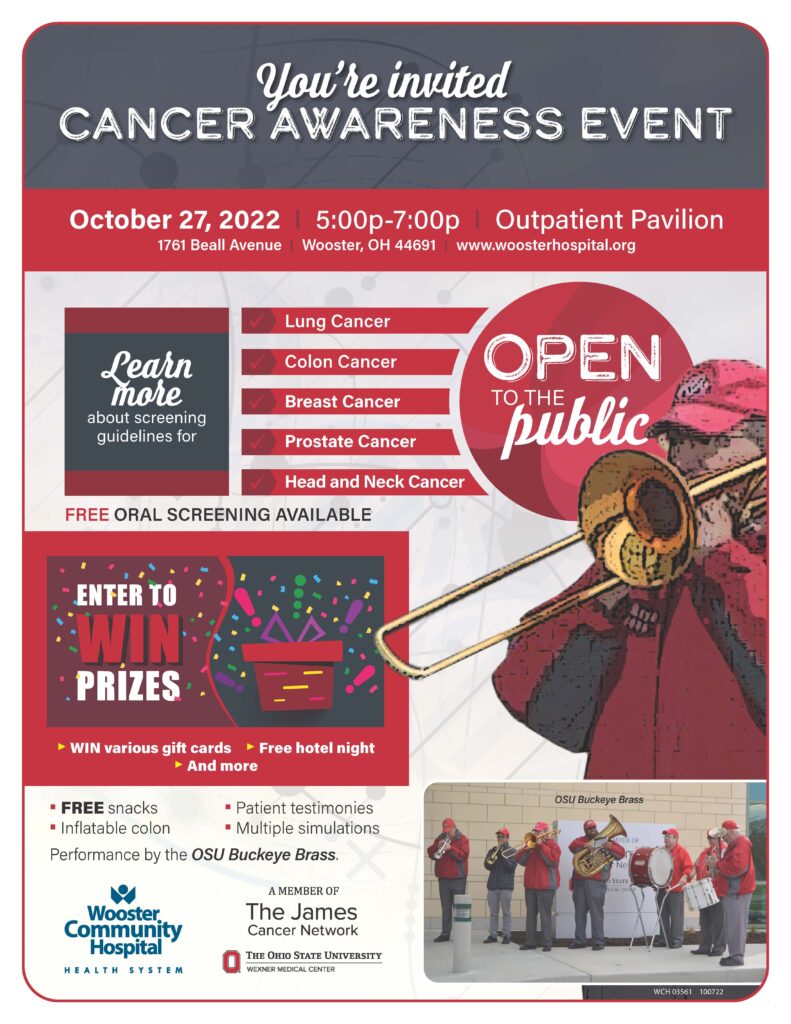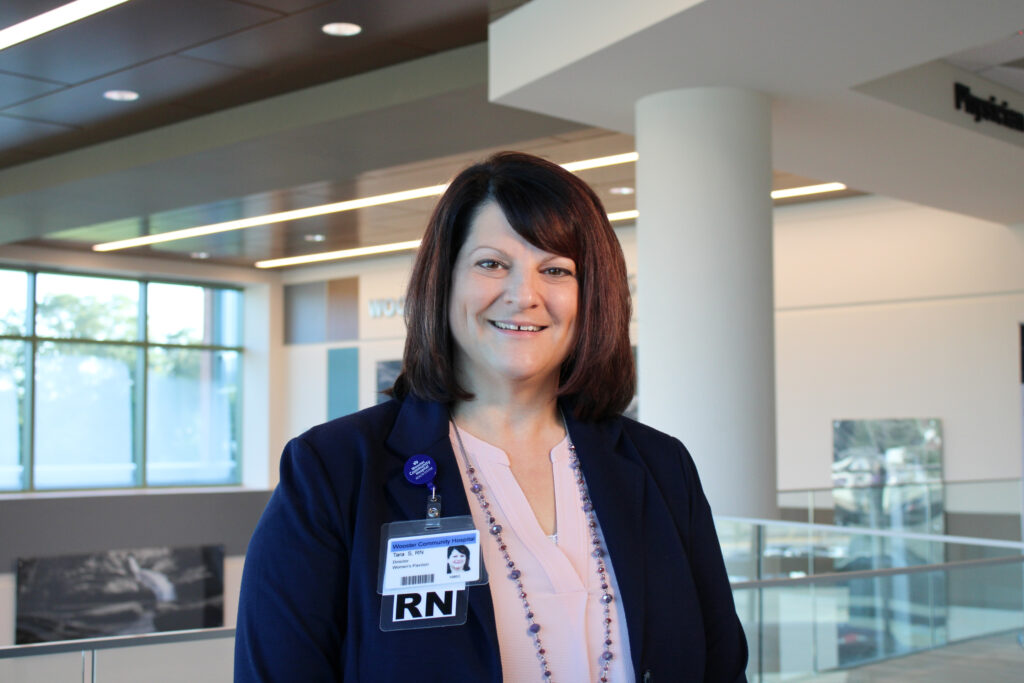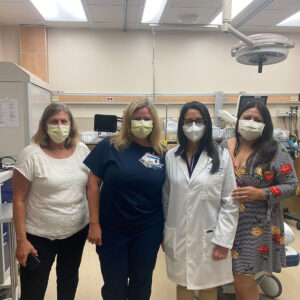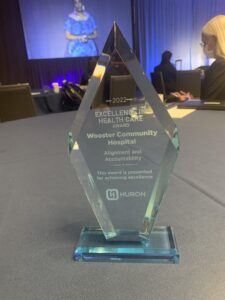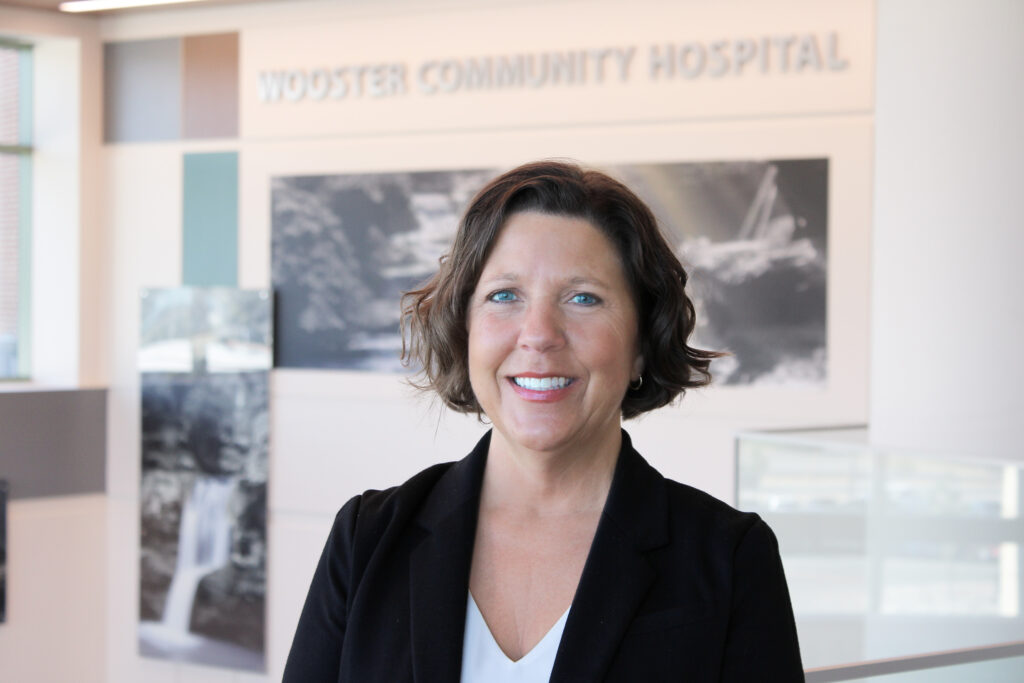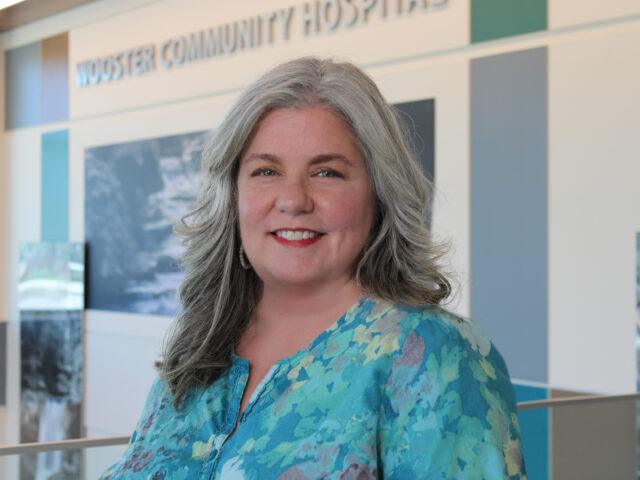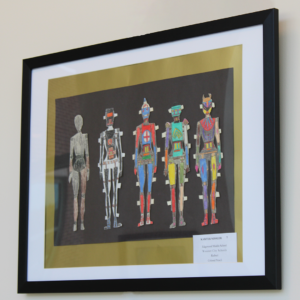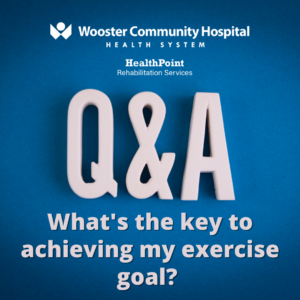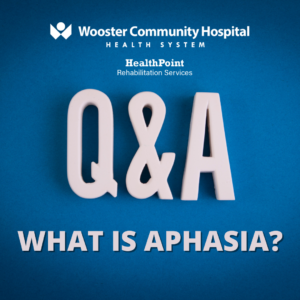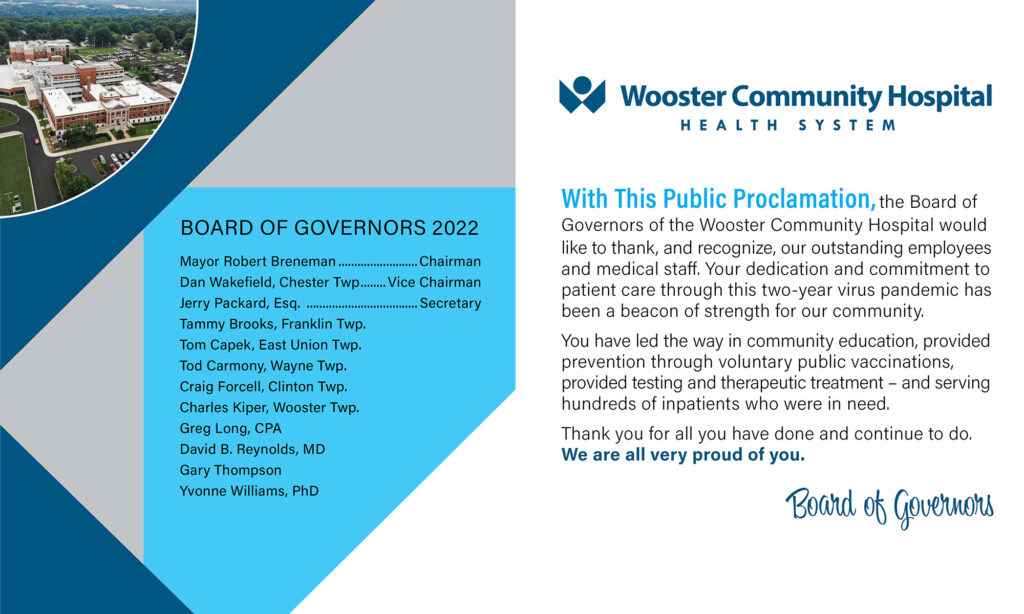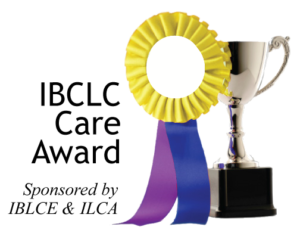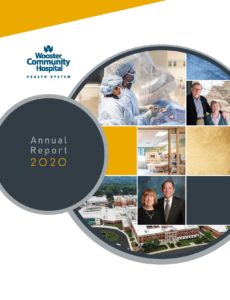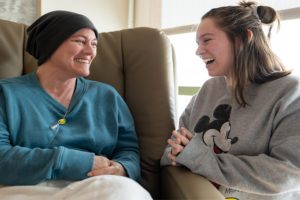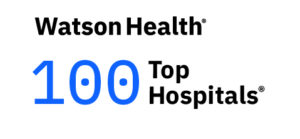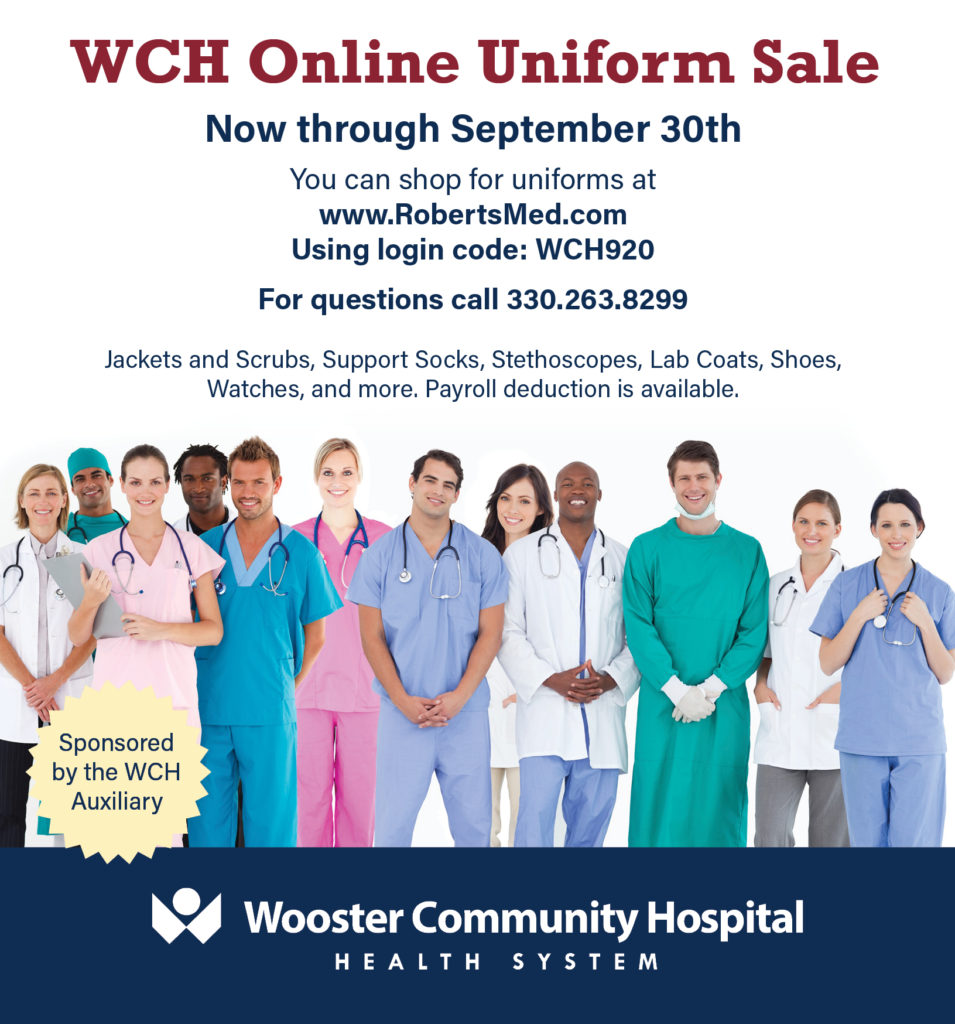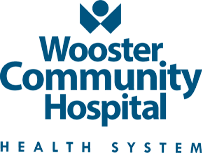
News
Wooster Community Hospital brings you up-to-date news about the latest developments in health care, as well as news about our hospital and events we sponsor.
Scott Boyes Promoted to CEO of Wooster Community Hospital Health System
Wooster, OH [June 27, 2024] Scott Boyes has taken over as CEO of Wooster Community Hospital (WCH) Health System. His primary objective is to ensure a seamless transition, where the changing of the guard would go unnoticed by anyone. "Bill Sheron has done such a good job of introducing new services, building upgraded facilities and taking care of the Wooster community that I just want to continue that legacy," Scott says.
And Scott is positioned well to do just that, having worked side by side with Bill for the past 25 years as the hospital CFO and in recent years in the COO role. Together they oversaw the construction of the east Patient Tower, HealthPoint facility, and the Outpatient Pavilion, all with NO debt. And they have kept WCH a locally owned and operated hospital, something that Scott is very passionate about.
"Being locally owned and operated allows us to truly put the community first," Scott says. "We have been able to expand our services and facilities to meet needs as our local Board of Governors sees fit."
In April, WCH held, a groundbreaking ceremony for a new patient access emergency center. And Scott is focused on a 5–10-year plan that will allow them to keep things at the highest level of care and quality overall.
"WCH has a tremendous culture of care," Scott says. "You can feel the difference. Even outside inspectors’ comment on our friendliness, excellence and cleanliness." But Scott is not satisfied to coast. "We want to be better at getting better."
While WCH has much going for it, today's hospitals are not without their challenges, Scott acknowledges. There are many "economic pressures as labor costs go up and a generation of boomers need more care. Medicare is 54% of our business and yet does not cover all the costs. We have to figure out how to be as efficient as we can while still keeping the quality of care."
Another challenge Scott would like to tackle is prevention. "We are great at sick care, but the answers lie in preventive care. Diagnostic tests, early detection and healthy living are important in bending the healthcare cost curve by keeping people healthy."
He credits his faith for guiding him in a career choice. “We like to think that what we are working on is bigger than the actual task. A hospital lives that task out through its mission.”
He and his wife, Susan, enjoy golfing and tennis. They also share the love of two grandchildren. “Everybody tells you that grand parenting is great, but you just can’t understand it until you experience it.” They are part of Scott’s motivation to keep WCH healthy and vibrant.
“When they are grown up and hopefully living in Wooster, I want them to be as proud of this hospital as I am now.”
Scott, a native of Wayne County, pursued his academic journey at the University of Akron, where he earned a bachelor’s degree in accounting. Not stopping there, he furthered his education by obtaining an MBA from the same institution.
Wooster Community Hospital Health System Welcomes Jason Rohr as New Chief Financial Officer
Demonstrates Commitment to Wooster Community and Reputation as 100 Top Hospital
Wooster, OH [June 13, 2024]: Wooster Community Hospital (WCH) Health System is excited to announce the appointment of Jason Rohr, MBA, as Chief Financial Officer (CFO). He will assume the role on June 20, 2024.
As CFO, Rohr aims to “build on to what WCH has established” and make a positive impact that will sustain healthcare in Wayne County and beyond. WCH has been ranked one of the nation’s 100 Top Hospitals® 10-times and has a 5-Star CMS rating.
Rohr’s goals include enhancing patient access to care and further improving the hospital’s operational efficiency in ways that positively contribute to the health of the community. He aims to improve managed care agreements and the patient financial experience and contribute to WCH’s ongoing success in team recruitment and retention.
Rohr received his Bachelor of science in accounting at the University of Akron, and his Master’s in business administration from Ashland University. Rohr brings years of experience in hospital finances to the WCH team, thanks to his previous work at Pomerene Hospital in Millersburg and Aultman Health Foundation in Canton.
Rohr has lived in Wooster for four years with his wife, Monica, and their four daughters. Our girls are very active in school activities and sports, at Triway. We enjoy spending quality family time together outdoors at the Wooster local parks.
“I feel very humbled and honored for the opportunity to serve as the CFO at Wooster Community Hospital,” Rohr said. “I’m really excited to have this opportunity to give back to the community where I live and contribute to the dedicated staff and leadership team that cares for its community.”
Wooster Community Hospital Named One of the Nation’s 100 Top Hospitals®
by Fortune and Premier’s PINC AI™
Wooster Community Hospital demonstrated lower inpatient mortality rates, with fewer readmissions and complications.
WOOSTER, OH (April 17, 2024) ─ Wooster Community Hospital was identified as one of the nation’s 100 Top Hospitals® according to an independent quality analysis provided by PINC AI™, the technology and services brand of Premier, Inc., and reported by Fortune.
To create the list, an objective, quantitative analysis of publicly available data was conducted to identify the top hospitals in the United States. The primary purpose of the PINC AI™ 100 Top Hospitals® program is to inspire hospital and health system leaders to pursue higher performance and deliver added value to patients and communities. The program leverages transparent, nonbiased data to help inform strategies for sustained performance. Organizations do not apply to participate in the study, and award recipients do not pay to market their honor.
“Years ago, our leadership team asked ourselves a challenging question when reviewing the list of the country’s 100 Top Hospitals. That question was “Why not us?” We quietly established this as a goal that we diligently worked to achieve, and it became a strategic imperative that drove a culture of excellence throughout the organization, said Bill Sheron, WCH CEO/President. “We always believed that we deserved to be on this list of outstanding hospitals - chosen by objective and unbiased data, and regardless of hospital size. Bigger doesn’t mean better, better outcomes mean you are better.”
“We were informed that we received this prestigious recognition again in 2024 – for the tenth time. Thousands of hospitals would be pleased to make this list even once, said Bill Sheron. “WCH has done it a remarkable ten times. We have a 5 Star Medicare rating and have also been listed in a national publication as one of the world’s best hospitals for several years running. This is an amazing accomplishment for our entire organization, and it reflects positively on our community. We thank our special employees, physicians, volunteers, and Board. This award provides affirmation of their commitment to quality care and a high level of patient satisfaction on a consistent basis over many years. We encourage everyone to pause and recognize what this award says about our organization, and the care we strive to deliver each and every day.”
100 Top Hospitals® Program Performance This year, based on comparisons between the study’s top performers and a peer group of similar hospitals, the analysis found that the top performers of the 100 Top Hospitals® program delivered better outcomes while operating more efficiently and at a lower cost. Compared to peer hospitals, this year’s top performers had:
- 39 percent fewer inpatient deaths than peer hospitals.
- 26.6 percent fewer patients with complications.
- 30.6 percent fewer healthcare-associated infections (HAIs).
- A 21.1 percent lower inpatient expense per discharge.
- 0.5-day shorter average length of stay.
- Better reported patient experience scores, with a top-box Hospital Consumer Assessment of Healthcare
- Providers and Systems (HCAHPS) score of 73 percent versus 67 percent for peer hospitals.
“Hospitals and health systems continue to recognize the vital importance of performance improvement for high-quality patient care, proving value and enabling the innovations that drive healthcare forward,” said Leigh Anderson, Premier’s Chief Operating Officer and the leader of PINC AI™. “The transparent, non-biased and actionable data this study provides helps leaders make informed decisions for change and proves that Wooster Community Hospital excels across a range of core performance indicators, which can directly lead to significantly higher quality patient outcomes, with fewer readmissions and complications.”
We apologize for any inconvenience caused, but we must inform you that the Fashion in Full BLOOMington schedule for April 25th has been CANCELED due to scheduling conflicts.
If you have registered for the event, a refund will be processed and issued to you this week.
Wooster Community Hospital (WCH) is excited to welcome Alan Ganci as the new Director of Accounting. In this role, he will oversee daily operations of the accounting department for WCH and Bloomington Medical Services (BMS).
Alan graduated from Eastern Illinois University with a bachelor’s in business with a major in accounting and received his MBA from Illinois State University. He has worked in hospital financial management since 1980, previously at two hospitals in Illinois before moving to Ohio in 1993.
Most recently he was the Interim Director of Accounting at Parma General. For the past 10 years he has owned and operated Wooster’s two Jimmy John’s restaurants and has decided to return to a healthcare role.
As Director of Accounting at WCH, Alan will help prepare monthly financial statements for WCH and BMS, supervise payroll and accounts payable, oversee preparation of annual budgets and cost reports and coordinate annual outside financial audits.
He hopes that he and his staff will be able to answer financial questions that will help other WCH departments better understand reports and effectively manage their teams. This would help the hospital remain efficient and optimally use resources to continue to provide quality healthcare at the lowest possible cost to the residents of Wooster and Wayne County.
Alan’s wife, Sondra, works as the cashier at WCH. Together they enjoy spending time with family and using their camper outside of Loudonville in the summer.
“I am blessed and happy to have this position,” Alan says. “We have a valuable resource here with the hospital; people don’t have to go outside Wayne County for quality care.”
Wooster Community Hospital Awarded on Newsweek’s World’s Best Hospitals 2024 List
[Wooster, OH, March 18, 2024] – Wooster Community Hospital been awarded on Newsweek’s list of World’s Best Hospitals 2024. Newsweek and Statista Inc., the world-leading statistics portal and industry ranking provider, present this prestigious award. The award was announced on February 28, 2024, and can be viewed on Newsweek’s website.
The World’s Best Hospitals 2024 ranking lists the best hospitals in 30 countries: USA, Germany, Japan, France, Italy, United Kingdom, South Korea, Brazil, India, Spain, Canada, Australia, Mexico, Colombia, Netherlands, Saudi Arabia, Switzerland, Taiwan, United Arab Emirates, Austria, Belgium, Chile, Malaysia, Thailand, Sweden, Denmark, Finland, Norway, Israel, Singapore. The countries were selected based on multiple comparability factors, such as standard of living/life expectancy, population size, number of hospitals, and data availability. Major changes were made in this year’s edition. A global board of renowned experts supports the continuous development of the methodology.
The lists are based on four data sources:
- Recommendations from Medical Experts: Online survey among tens of thousands of doctors, health care professionals, and hospital managers in 30 countries.
- Results from Patient Surveys: Survey of patient satisfaction with hospitalization.
- Hospital Quality Metrics: Medical indicators e.g., data on quality of care for treatments, hygiene measures, patient safety, and waiting times.
- PROMs Implementation Survey: Optional online survey on the implementation and use of PROMs in hospitals.
Based on the above four pillars and their respective weights, a final source was calculated for each hospital.
Wooster Community Hospital is ecstatic to be recognized on Newsweek’s World’s Best Hospitals 2024 list.
“We are honored, but not surprised, to be included in the list of the World’s Best Hospitals,” said Bill Sheron, Wooster Community Hospital President/CEO. “This validates what we do every day and try to share with our community – that great hospitals are defined by the measurable quality of the patient care and experience they deliver – not by their size or name awareness. Kudos to our Board and the world class team of employees and physicians. You make a difference for many people.”
Wooster Community Hospital is among “The Top of the Top” at the PINC AI, 100 Top Hospitals award ceremony in Scottsdale, Arizona! Proudly celebrating our 9th prestigious distinction, the photo includes (R to L) Tara Raudebaugh, WCH vice president of quality management, Tod Carmony, WCH Board member, and his wife Pat Carmony.
Wooster, Ohio (February 28, 2024) — After 40 years as a hospital CEO, 30 of them at Wooster Community Hospital (WCH). Bill Sheron has announced his impending retirement. Scott Boyes, CFO/COO, will succeed Sheron as President/CEO after a new CFO is hired. No exact timetable has been set for the transition.
“I am extremely proud to be part of this outstanding management team,” said Sheron.
Sheron also cited numerous things he is most proud of, including the construction of a new patient tower, the creation of a cancer center, the recruitment of many excellent cardiology physicians, and the development of cardiology services.
“Full-time cardiology care did not exist when I came here,” he said. “I think we've done a remarkable job not only offering basic cardiology, but also diagnostic catheterization and interventional cardiology, where you can treat blockages.”
Another achievement highlighted by Sheron was the planning and building of the HealthPoint facility—our health and wellness center on the north end of Wooster—20 years ago. “That allowed us to expand from just being a hospital to also taking care of people who are rehabilitating and just wanting a place to exercise. We have also advanced stroke care in our community and have a certified stroke center,” said Sheron.
Sheron also noted the many awards WCH has received during his tenure, including nine national “Top 100” awards and being named one of the world’s best hospitals three times.
“The hospital was the Wooster Area Chamber of Commerce Business of the Year twice, which is a big honor, and I was chosen for the Chamber of Commerce Wall of Fame last year, so all of those things are special,” he said. “Our collaboration with the College of Wooster, Akron Children’s Medical Center and Ohio State University have helped expand care locally.”
Sheron said he is looking forward to having more time to spend with his family, which includes his wife, Carolyn—a retired school teacher, three grown children and two grandchildren.
“I'm not going anywhere,” he said. “We’re going to stay in Wooster, and I will continue to serve on some local boards. “[WCH] has been a true community hospital since it was founded in 1950 and I'm very proud to say I've been part of that for 30 years.”
Boyes, who was born at WCH and is a graduate of the University of Akron, has been with WCH for 25 years.
Boyes, who is married and has three grown children and two grandchildren, lives in Wooster.
“Our succession plan all along has been for Scott to take my position when I retire,” Sheron said. “It should be a smooth transition as everybody knows Scott and his management style. I congratulate him on this well-deserved promotion and am happy for him. I am also grateful to the hospital Board for giving me the opportunity many years ago.”
Saturday, March 2nd
Wooster Community Hospital, Outpatient Pavilion
9a - Noon
Providers from
Bloomington Medical Services & Milltown Family Physicians
will be performing the screenings
Coffee & Light Morning Snacks Provided
By Appointment, call to schedule today!
(330) 202-5691
Wooster Community Hospital Welcomes Back Monique Pizzute as Director of WCH Hyperbaric Medicine & Wound Healing Center
Demonstrates Commitment to Wound Care in Wooster and Surrounding Communities
Wooster, OH [January 18, 2024]: Wooster Community Hospital (WCH) is excited to welcome back Monique Pizzute as the director of the WCH Hyperbaric Medicine & Wound Healing Center. In this role, she will oversee general facility operations, raise community awareness of the services, and help the facility with the upcoming relocation.
The Wound Healing Center will be moving into a new facility later in 2024. Construction began in January at 1685 Cleveland Road in Wooster.
“We’re excited to welcome Monique back to lead the wound healing team,” said WCH VP of Patient Services/CNO, Shelly Huff. “She brings invaluable knowledge and experience and we’re thrilled to have her here to further enhance our wound healing and hyperbaric program.”
Pizzute received her B.S. with a concentration in long-term care administration and master’s degree in business administration from Kent State University. She has a background in gerontology and has previously worked in wound healing and hyperbaric medicine, long term care, skilled nursing, assisted living and memory care facilities.
“It is exciting to be returning to Wooster Community Hospital and the Wound Healing. I have truly missed my time here and I’m thrilled to be working in such a great community again,” Pizzute says. “Our experienced providers offer effective, compassionate services that really make a difference in patients’ lives. We look forward to continuing our commitment to excellence in our new facility later this year.”
Read our most recent Community Focus Magazines containing patient stories and services provided at WCH here:
[Wooster, OH] – November 15, 2023 – WCH Skilled Nursing Unit has been recognized again as a Best Nursing Home for 2024 by U.S. News & World Report.
Since 2009, U.S. News’ annual Best Nursing Homes ratings have assisted consumers in need of either short-term rehabilitation or long-term care for themselves or a family member.
WCH Skilled Nursing Unit earned its U.S. News Best Nursing Home status by achieving a rating of “High Performing,” the highest possible rating, for Short-Term Rehabilitation. U.S. News gives the designation of Best Nursing Home only to those that satisfy U.S. News’ assessment of consistent performance in quality measures.
“Our skilled nursing facility consistently provides exceptional care for patients, said Bill Sheron, WCH President/CEO. “Located within the hospital, this specialized unit has all the resources of the hospital – physical therapy, an on-site medical director and physicians, pharmacy, social workers, dietitians and a chef – on the premises. I believe this helps differentiate us from other facilities. We have developed an excellent reputation in the region, and typically have a waiting list for patients seeking admission. The unit is overseen by a dedicated nursing staff, and they deserve a tremendous amount of credit. We are pleased to, once again, receive national recognition for everyone’s outstanding work and patient outcomes.”
For the 2024 edition, U.S. News rated more than 15,000 nursing homes on patient and resident outcomes, such as infection rates; staffing levels; potentially inappropriate reliance on antipsychotic drugs; health inspection results and other indicators of quality.
To calculate the Best Nursing Homes ratings, U.S. News evaluated each nursing home’s performance using a variety of quality measures obtained from the Centers for Medicare & Medicaid Services (CMS). The U.S. News methodology factors data such as resident care, safety and outcomes. Both short- and long-term ratings include data on nurse staffing, use of antipsychotic drugs and success in preventing ER and hospital visits. The long-term care rating also includes measures of whether a home changed ownership and how well they were staffed on weekends.
“U.S. News’ Best Nursing Homes ratings give patients, senior residents, their families and caregivers an objective assessment of quality, to help them choose the facility that best fits their individual needs,” said Ben Harder, chief of health analysis and managing editor at U.S. News. “Nursing homes that have earned the recognition of U.S. News have a track record of achieving better outcomes for patients and residents, and maximizing the amount of care they receive from nurses and other staff.”
Wooster Community Hospital Named One of the Nation’s 100 Top Hospitals®
by Fortune and PINC AI™
Wooster Community Hospital demonstrated lower inpatient mortality rates, with fewer readmissions and complications.
WOOSTER, OH (September 22, 2023) ─ Wooster Community Hospital (WCH) was identified as one of the nation’s 100 Top Hospitals® according to an independent quality analysis provided by PINC AI™ and reported by Fortune.
To create the list, an objective, quantitative analysis of publicly available data was conducted to identify the top hospitals in the United States. The primary purpose of the PINC AI™ 100 Top Hospitals® program is to inspire hospital and health system leaders to pursue higher performance and deliver added value to patients and communities. The program leverages transparent, nonbiased data to help inform strategies for sustained performance. Organizations do not apply to participate in the study, and award winners do not pay to market their honor.
“We are proud to again be selected as one of the nation’s 100 Top Hospitals. The information which follows underscores WHY this award should be impactful for patients and our community,” said Bill Sheron, WCH CEO/President. “We hope all patients utilize such information to make informed choices.”
Bill Sheron continues, “Having received this recognition now a total of nine times underscores our staff’s commitment to sustained excellence in patient care, satisfaction, and outcomes. Very few hospitals can match this level of achievement. This award means a great deal to us, and we thank everyone involved for making our hospital such a special place.”
Tara Raudebaugh, WCH’s VP of Quality Management, remarked “We are delighted to be on this distinguished list of 100 Top Hospitals! The Board, executive leadership, staff, and providers are always striving to provide the very best care, and this validates the value we provide to the patients and community we serve. Being a repeat winner demonstrates our sustained improvement and achievement in quality, safety, outcomes, operations, and financial performance.”
100 Top Hospitals® program performance This year, based on comparisons between the study winners and a peer group of similar hospitals that were not winners, the analysis found that the winners of the 100 Top Hospitals® program delivered better outcomes while operating more efficiently and at a lower cost. Compared to non-winning hospitals, this year’s winners had:
- 31 percent fewer deaths than non-winning hospitals.
- 9 percent fewer patients with complications.
- 39 percent fewer healthcare associated infections (HAIs).
- Nearly 20 percent lower inpatient expenses per discharge.
- 0.5-day shorter average length of stay.
- Better reported patient experience scores, with a top-box Hospital Consumer Assessment of Healthcare Providers and Systems (HCAHPS) score of 77 percent versus 70 percent for non-winning hospitals.
“As hospitals continue to share the nation’s focus on changing healthcare for the better, hospitals and health systems are recognizing the importance of identifying areas within their walls for quality improvement,” said Leigh Anderson, Premier’s Chief Operating Officer and the leader of PINC AI™. “The transparent and nonbiased measures this study provides, helps leaders make informed decisions for change, and proves that Wooster Community Hospital excels across a range of core performance indicators, which can directly lead to significantly higher quality patient outcomes, with fewer readmissions and complications.”
Wooster Community Hospital Quality Care: Centers for Medicare & Medicaid 5-Star Hospital Rating Highlights Superior Healthcare
Wooster, OH— {September 14, 2023} Every year the Centers for Medicare & Medicaid (CMS) rate over 3,000 acute care hospitals across the nation. And every year Wooster Community Hospital (WCH) scores well. This year they notched a 5-star rating again.
“It’s a big deal,” said Tara Raudebaugh, WCH Vice President of Quality Management. “We are the only acute care hospital in the area who was awarded the 5-star rating this year.”
The CMS considers five quality metrics: readmission, mortality, safety of care, timely and effective care, and patient ratings.
“This rating really speaks to our culture and teamwork as well as the expertise of our staff and providers,” said Tara. “Without the right people and processes in place, a 5-star rating isn’t possible. We are always striving to reach the next level of excellence. We are never satisfied with status quo.”
Michelle Quisenberry, Director of Marketing & Public Relations, wants patients to know they have a choice for their care. “You can choose where you have your surgery. We are a 100 Top Hospital as well. Patients should look carefully at their options.”
Publicly reported information regarding the 5-Star rating can be found at medicare.gov/care-compare/.
WOOSTER COMMUNITY HOSPITAL HEALTH SYSTEM IS NATIONALLY RECOGNIZED FOR ITS COMMITMENT TO PROVIDING HIGH-QUALITY STROKE CARE
Wooster, OH— {July 10, 2023} Wooster Community Hospital (WCH) Health System has received the American Heart Association’s Get With The Guidelines® - Stroke Gold Plus quality achievement award for its commitment to ensuring stroke patients receive the most appropriate treatment according to nationally recognized, research-based guidelines, ultimately leading to more lives saved and reduced disability.
Stroke is the No. 5 cause of death and a leading cause of disability in the U.S. A stroke occurs when a blood vessel that carries oxygen and nutrients to the brain is either blocked by a clot or bursts. When that happens, part of the brain cannot get the blood and oxygen it needs, so brain cells die. Early stroke detection and treatment are key to improving survival, minimizing disability, and accelerating recovery times.
“WCH is the only Certified Primary Stroke Center in Wayne, Holmes & Ashland counties. We are especially proud of this certification, as it allows us to treat most stroke patients in our community, close to home. We’re committed to improving patient care by adhering to the latest treatment guidelines, Amelia Welsh, RN, CCRN, Critical Care/Stroke Coordinator. “Get With The Guidelines makes it easier for our teams to put proven knowledge and guidelines to work on a daily basis, which studies show can help patients recover better. The end goal is to ensure more people in Wayne and surrounding counties can experience longer, healthier lives.”
Each year, program participants qualify for the award by demonstrating how their organization has committed to providing quality care for stroke patients. In addition to following treatment guidelines, Get With The Guidelines participants also educate patients to help them manage their health and recovery at home.
WCH also received the American Heart Association’s Target: StrokeSM Elite Honor Roll award. To qualify for this recognition, hospitals must meet specific criteria that reduces the time between an eligible patient’s arrival at the hospital and treatment with the clot-buster Alteplase or Tenecteplase.
Additionally, WCH received the American Heart Association’s Target: Type 2 Honor Roll award. Individuals with Type 2 Diabetes may be at might be at higher risk for complications, receive the most up-to-date, evidence-based care when hospitalized due to stroke.
WCH is excited to announce Scott Wilson as Director of Environmental Services. In May of 2019, Scott moved to Wooster to become the supervisor of EVS here at Wooster Community Hospital and now as Director he feels like WCH is his "second home".
Formally, Scott worked in the transportation logistics industry for 18 years in several management roles. He also owned and operated a commercial and industrial cleaning company for several years. Scott attended Gallipolis Business College in Gallipolis, OH.
Wooster Community Hospital Health System (WCH) is excited to announce the appointment of Douglas Nichols as Laboratory Director. Formerly laboratory manager of phlebotomy and processing at University Hospitals Cleveland Medical Center, Nichols brings experience and education that is ideally suited to WCH’s commitment to exceptional laboratory services.
Nichols received his Bachelor of Science in Medical Technology at the University of Findlay, and his Master of Business Administration at Franklin University in Columbus. He also brings experience working as a Medical Laboratory Specialist for the United States Army at the 47th Field Hospital and Reynolds Army Community Hospital in Fort Sill, Okla.
In his new role at WCH, Nichols will be overseeing all laboratory operations for patient testing. He will be promoting updates to various laboratory testing equipment in microbiology, chemistry and molecular testing to continue to support the testing needs of WCH patients.
“I am excited and honored to take on this new role as the Laboratory Director here at Wooster Community Hospital, as the laboratory team is committed to provide high quality service and results to our patients,” Nichols says.

“I am Thankful for the Mayor’s appointment and City Council’s approval to work with and learn from such an experienced and successful leadership team, and I am excited to help support our community hospital’s future.” ~ Kyle.
Kyle joined Stifel in 2018 after spending nine years as a financial advisor and one year as an intern with Wells Fargo Advisors and its predecessor firm, Wachovia Securities.
Kyle was named to Forbes’ Top Next-Gen Wealth Advisors list in 2017, 2018, 2020, 2021, and 2022, and to Forbes’ Best-in State Wealth Advisors list in 2018, 2021, and 2022. He was also named to AdvisorHub's National Fastest Growing Advisors To Watch and 25 Next Gen Advisor To Watch lists in 2022. He earned the Chartered Retirement Planning CounselorTM designation and holds Series 7 and 66 securities licenses.
Kyle grew up in North Canton, Ohio. He earned a B.A. in Economics Management from Ohio Wesleyan University, where he was a four-year starting running back and captain of the Battling Bishop football team. Outside the office, Kyle serves as a trustee for Goodwill of Wayne and Holmes Counties, a voting member of the Wooster City Planning Commission, a member of Wooster Kiwanis, a board member of Adaptive Sports of Ohio, a board member for the Wooster Community Hospital Health System, and running backs coach for the College of Wooster. Kyle lives in Wooster with his wife, Sara, and their two boxers.
[WOOSTER, OH] – January 24, 2023− [WCH Skilled Nursing Unit] has been recognized as a Best Nursing Home for SHORT-TERM REHABILITATION, for 2022-2023 by U.S. News & World Report.
The annual Best Nursing Homes ratings, now in their 13th year, assist prospective residents and their families in making informed decisions in consultation with their medical professionals about where to receive short-term or long-term nursing home care. Only 16% of U.S skilled-nursing facilities earned the “Best Nursing Home” designation this year.
“We are pleased to, once again, have our TCU skilled nursing unit – which call our Transitional Care Unit – recognized among the best in Ohio and in the top 16% in the nation," said Bill Sheron, President/CEO, Wooster Community Hospital. "It demonstrates a consistent commitment to high level care and is a testament to our outstanding staff and Medical Director. We trust that patients and families utilize such rankings when making their health care choices.”
For 2022-2023, U. S. News rated more than 15,000 nursing homes on care, safety, infection rates, staffing and health inspections. For the first time, the Best Nursing Homes ratings feature a new measure on weekend staffing and another new measure on infection rates that led to hospitalizations.
“Choosing the right nursing home based on care needs and comfort is a critical decision for prospective residents and their families,” said Zach Adams, health data engineer at U.S. News. “The Best Nursing Homes ratings highlight nursing homes that excel in short-term rehabilitation and long-term care needs.”
The Best Nursing Homes methodology factors data such as resident care, safety, and outcomes. To calculate the Best Nursing Homes ratings, U.S. News evaluated each nursing home’s performance using a variety of data obtained from the Centers for Medicare & Medicaid Services (CMS). Both short-term and long-term ratings include data on consistency of registered nurse staffing, use of antipsychotic drugs, and success in preventing ER and hospital visits. The long-term care rating also includes measures of whether a home changed ownership and how well they were staffed on weekends. The short-term rehabilitation rating also includes measures of a home’s success in preventing falls, preventing serious infections, and making sure residents are able to return homes.
Limited reservations available.
Wooster Community Hospital Welcomes Tara Snyder as Director of Women’s Pavilion
Demonstrates Commitment to Maternity Care Throughout the Wayne County Community
Wooster, OH [September 22, 2022]: Wooster Community Hospital Health System (WCH) is excited to announce the appointment of Tara Snyder as Director of the WCH Women’s Pavilion. Born and raised in Wooster, Snyder’s experience, education and personal history is ideally suited to WCH’s commitment to exceptional maternity care.
Snyder received her Bachelor of Science degree in Nursing at Kent State University and her Master of Science degree in Nursing, Education at Walden University. Snyder was previously Executive Director Nursing Services at Aultman Orrville Hospital. She has more than 20 years of experience as an obstetrics nurse and more than 8 years of leadership experience. Her hobbies of camping and working on a family share farm demonstrate her commitment to health and wellness.
The Women’s Pavilion houses WCH’s obstetrics unit, which offers exceptional, personalized maternity care for women, babies and families. This unit has been designed to ensure that childbirth is a cherished, memorable occasion. Providers and nursing staff are prepared to accommodate birth plans and respect the wishes of mothers and families. The Women’s Pavilion features spacious private birthing suites, breastfeeding support services, and childbirth education classes. Facility tours are available. For more information, please visit our website at woosterhospital.org/services/obstetrics-womens-pavilion.
“I’ve had a connection to Wooster Community Hospital since I worked there in my teens as a candy striper," Snyder says. "I was born and raised in Wooster and love the community here. I am looking forward to serving my hometown and its growing families.”
We are excited to share the Congratulatory video for the staff at Wooster Community Hospital from a few of the local area businesses for being named a 100 Top Hospital for the 8th TIME! Thank you all for your support! Check it out!
Great news! Wooster Community Hospital has developed a new app, WCHConnect, to help patients better manage their healthcare and take advantage of our high-quality services. Starting September 10, 2022 you can download the WCHConnect app to log onto the WCH eCare Patient Portal, where you can see test results, get appointment reminders, request prescription refills, and estimate costs for common health services. The app also allows users to see WCH provider profiles, find career opportunities, watch WCH videos, view class schedules, and sign up for our new WCH Friends Program. Get started by downloading our app today!
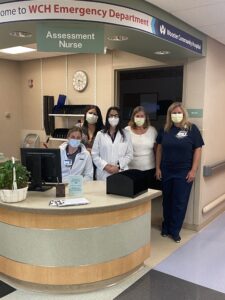
August 10, Wooster OH... This August, the new senior leadership of Hospital Regional de Occidente visited Wooster Community Hospital during a ten-day mission to study best practices that will help elevate quality of care in Honduras’ largest public hospital. The visit, necessitated by recent political upheavals in that country, was arranged and funded by Central American Medical Outreach (CAMO) of Orrville.
Dr. Marith Lopez, an OB/GYN physician, and Lourdes Hernandez, a banking executive with expertise in risk management, were recently appointed by the new government of Honduras to the top two positions of the Hospital de Occidente. Their challenge: the outgoing Honduran president ordered all files of every government-run institution erased, leaving the new leadership with an impossible learning curve and few resources to fall back on.
“Their relationship with CAMO has been ongoing for years in their former positions,” recalls Kathy Tschiegg, founder of CAMO. “As we recognized their struggle in what amounts to a broken system, we asked how we might help. Their answer: the opportunity to see a good hospital model.” As an eight-time recipient of the Fortune/Merative (formerly IBM Watson Health) 100 Top Hospitals award, WCH was an obvious choice.
Together with WCH leadership, Dr. Lopez and Ms. Hernandez spent four days observing best practices, logistics procedures, departmental protocols (such as facilitating patient flow/access and privacy in the ER for example) and health information management. Given the dire condition of their hospital’s entire warehousing/medical supply system, they spent considerable time with WCH’s materials management experts, learning how the hospital handles inventory control, expiry date stock rotation, etc.
“In just about every respect, this 300-bed, full-service hospital in Honduras faces enormous obstacles... from crowding and deteriorating technology to staffing and budget inequity,” observes Angela Rincon, WCH Director of Development. “Two patients sharing one bed is commonplace. Our visitors are literally starting over in improving management of health services, operations, HR and hospital infrastructure. It’s about saving lives and improving quality of life for hundreds of thousands of families... a mission we genuinely understand.”
Launched in 1993 by former Peace Corps nurse, Kathryn M. Tschiegg, RN, BBA, CAMO is a non-denominational, Christian-based, humanitarian organization that brings life-saving medical services, education and community development to Central America. The CAMO model was designed by Ms. Tschiegg. “As a Peace Corps nurse, I witnessed 31 babies die in one month as a result of not having the supplies, equipment and educated staff to save them. Today, infants and adults are being saved daily due to the CAMO model.” From CAMO’s first program, 18 other programs have branched off, bringing services to meet the needs that otherwise would not have been met.
For more information, please contact:
Angela Rincon, Director of Development
Wooster Community Hospital Health System
arincon@wchosp.org
(330) 263-870
Wooster Community Hospital Named Recipient of Huron’s 2022 Excellence in Healthcare Award
Recognized for [delivering exceptional outcomes or driving innovations]
Wooster, OH (July 27, 2022)— Wooster Community Hospital announced it has received the 2022 Excellence in Healthcare Award from Huron, a global professional services firm, at its 20th annual What’s Right in Health Care® conference on August 8-10, 2022. Wooster Community Hospital is being recognized for excellent outcomes and innovations which positively impacts its people, consumers, or business operations.
“News of this award was a pleasant surprise,” said WCH CEO, Bill Sheron. “Huron is a leading national healthcare advisory company, and to be selected as one of only two recipients of this award is noteworthy. It is yet another example of our hospital being independently recognized as a national leader in healthcare outcomes and innovation.”
“We congratulate Wooster Community Hospital on this well-deserved achievement,” said Debbie Ritchie or Curt Whelan, managing director at Huron. “This recognition is a testament to the innovation and resilience of their teams enabling them to achieve performance excellence throughout the past year.
Huron’s Excellence in Healthcare Awards are presented annually to a select group of organizations which demonstrate What’s Right in Health Care® and [deliver exceptional outcomes to patients or drive innovations]. To be eligible for an award, an organization must demonstrate outstanding performance and achievement in areas such as patient care, and employee and physician engagement.
The What’s Right in Health Care® conference is for healthcare leaders eager to think critically about bringing more innovation to their organization, prioritizing a high-performing and engaged workforce. Over the two-and-a-half days, attendees have the opportunity to connect with peers and find inspiration in their path to organizational improvement and become an ambassador for cultural growth, positive clinical and operational outcomes, and advanced leadership skills. Conference attendees joined in-person and virtually to hear inspiring stories and best practices from other high-performing healthcare leaders and staff across the care continuum.
About Wooster Community Hospital
Wooster Community Hospital (WCH) is an 8-time Fortune/Merative 100 Top Hospital (formerly IBM Watson Health) that offers a complete range of inpatient and outpatient services. WCH strives to expand facilities and add services to meet the needs of our community. Through ongoing quality improvement initiatives, WCH is always working to provide the highest quality care and treatment. Additionally, WCH was named by CMS (Centers for Medicare Services) as a 5-Star facility and recognized as part of Newsweek’s annual list of World’s Best Hospitals for 2021/2022. For more information, visit www.woosterhospital.org.
Wooster Community Hospital Health System President/CEO Bill Sheron and Vice President, CFO/COO Scott Boyes were both featured presenters at the QHR Health 2022 national leadership conference in Nashville on July 21, 2022. Additionally, seven WCH board members attended the event. Together Sheron and Boyes presented, “Pursuit of Excellence: Delivering Exceptional Care While Growing People, the Organization, and the Business.” QHR Health is a consultant organization that works with independent U.S. hospitals and health systems to help them achieve their best outcomes. The meeting included QHR leaders as well as other healthcare innovators and entrepreneurs. Attendees heard presentations on how to increase patient engagement, strategies to grow physician specialties, and updates on QHR Health itself.
#100TopHospitals
[WOOSTER, OH] - [July 6, 2022] – Wooster Community Hospital (WCH) has been named to the 2022 Fortune/Merative 100 Top Hospitals® list. This is the EIGHTH TIME WCH has been recognized with this honor as one of the top performing hospitals in the U.S. The annual list was published by Fortune.
Merative, a data, analytics and technology partner for the health industry, has identified the top hospitals from a rigorous evaluation of 2,650 short-term, acute care, non-federal hospitals in the U.S. The annual list recognizes excellence in clinical outcomes, operational efficiency, patient experience, and financial health. Merative, formerly IBM Watson Health, established the list to help identify best practices that may help other healthcare organizations achieve consistent, balanced, and sustainable high performance.
"For us, the 100 Top Hospital award is one of the most important we could receive, said Bill Sheron, President/CEO. “WCH not only made the Fortune/Merative 100 Top Hospital list, but now has done so eight times. Very few hospitals can demonstrate that kind of sustained excellence and top performance. That we could achieve such excellence, especially during a pandemic, is a testament to our dedicated employees and medical staff. The award independently validates what we at WCH already knew: that our team can deliver measurable, outstanding care.”
Wooster Community Hospital Health System is a 172-bed, full-service and acute-care facility. Located in Wooster, the hub of Wayne County, OH. Since inception in 1950, we have expanded our facilities and added services to meet the need of patients in our community. WCH strives to provide quality health care services to all people, all the time. Through ongoing quality improvement initiatives, WCH is always working to provide the highest quality care and treatment.
Recognition as one of the Fortune/Merative 100 Top Hospitals demonstrates Wooster Community Hospital’s ongoing commitment to prioritize patient-centered care. According to Merative, as compared to similar hospitals, the hospitals included on the Fortune/Merative 100 Top Hospitals list had better results on key clinical and operational performance indicators. These include survival rates, patient complications, healthcare associated infections, 30-day mortality and 30-day hospital-wide readmission rates, length of stay, throughput in emergency departments, inpatient expenses, profitability and ratings from patients.
The Fortune/Merative 100 Top Hospitals lists also incorporates a community health measure into its ranking process. For the community health measure, hospitals were surveyed across three components: 1) assessing hospital contributions to community health as a provider of critical services for community health and preventive care; 2) identifying ways that hospitals contribute to community health as a community partner teaming up with local organizations to implement critical programs; and 3) focusing on ways that hospitals promote community health through their practices as anchor institutions supporting local economic and social progress. The community health measure is weighted equally with other ranking measures.
For more information, visit http://www.100tophospitals.com/.
About Wooster Community Hospital
Wooster Community Hospital (WCH) is an 8-time Fortune/Merative 100 Top Hospital that offers a complete range of inpatient and outpatient services. WCH strives to expand facilities and add services to meet the needs of our community. Through ongoing quality improvement initiatives, WCH is always working to provide the highest quality care and treatment. Additionally, WCH was named by CMS (Centers for Medicare Services) as a 5-Star facility and recognized as part of Newsweek’s annual list of World’s Best Hospitals for 2021/2022. For more information, visit www.woosterhospital.org.
About the Fortune/Merative 100 Top Hospitals® List
The Fortune/Merative 100 Top Hospitals list is determined using independent and objective research to analyze hospital performance. Organizations do not apply or pay for this honor or pay to promote their award. Award-winning hospitals serve as a model of excellence for the industry.
About Merative
Merative is a data, analytics and technology partner for the health industry, including providers, payers, life sciences companies and governments. With trusted technology and human expertise, the company works with clients to drive real progress. Merative helps clients orient information and insights around the people they serve to improve healthcare delivery, decision making and performance. Formerly IBM Watson Health, Merative became a new standalone company as part of Francisco Partners in 2022. Learn more at www.merative.com.
WOOSTER, OH (July 6, 2022) -- We are excited to announce that Mary Andre has accepted a promotion to Director of Operations for Bloomington Medical Services (BMS). As an affiliate of Wooster Community Hospital (WCH) Health System, BMS operates a multispecialty physician practice and provides physician management services.
Mary first joined WCH as an Administrative Executive Assistant in 2013 and received a promotion to Physician Liaison in 2014. In 2019, she was promoted to Coordinator of Provider Relations and Administrative Support. Mary received her Bachelor of Arts from the University of Akron, with a double major in history and english.
She has been married for 30 years and is the mother of two and grandmother of six.
WOOSTER, OH (July 1, 2022) -- We are thrilled to announce that Tara Raudebaugh has accepted the position of Vice President of Quality Management. Tara has been with Wooster Community Hospital Health System since 1997, first as a perinatal staff RN, then as Director of Perinatal Services in July 2011. In her previous role, Tara had operational and clinical responsibility for the perinatal service line, which includes 1,200 births a year and a 70-person team. Tara earned her Bachelor of Science in Nursing at the Ohio State University and her Master of Science in Nursing at Indiana Wesleyan University.
Tara has been married to her wonderful husband David for 22 years. They enjoy spending time with their 4 children and 3 grandchildren.
WCH is excited to welcome Tara to the Administrative team.



Be ready to be inspired...
Now through July 31, 2022, Wooster Community Hospital is proud to offer another remarkable student art exhibition, this time featuring Edgewood Middle School’s
fifth-through-seventh-grade students. Colorful, eclectic and utterly fresh views of the everyday and the amazing, these creations are already inspiring our staff and recent visitors. Now it’s your turn to be inspired as you stroll down the Outpatient Pavilion Concourse on the ground floor at WCH... or peer in through the big windows from outside on the next sunny summer day. This exhibition is presented in collaboration with the Wayne Center for the Arts. We hope you’ll find a moment to stop by and enjoy the show.


This ought to cheer you up...
Wooster Edgewood Middle School Students’ Gift of Artwork Will Brighten WCH Cancer Center.
Earlier this spring, WCH CEO Bill Sheron received a remarkable letter from a fifth grade teacher at Edgewood Middle School, regarding an even more remarkable gift: a collection of student-created artworks intended to lift the spirits of our patients. The letter explained how Edgewood has set up “lead groups” throughout the school to give back to Wooster through community projects, and how Mr. Steve Fox’s fifth grade lead group chose our Hospital as recipient of these bright, cheerful, even humorous works of art.
On May 20th, Director of Development Angela Rincon visited Edgewood for the presentation of the artwork, which will be displayed in our Cancer Center Infusion Bays. “Each student spoke briefly about his or her painting before presenting it to the Hospital... including one student cancer survivor,” she recounted. “It was a remarkable, generous and genuinely uplifting event. Our Cancer Center Director, Michelle Flory loves the paintings, which will rotate from bay to bay so patients can enjoy different works when they visit for their treatments.”
From the entire Wooster Community Hospital family, a huge thank-you to Edgewood Middle School and Mr. Fox’s fifth-grade artist/philanthropists... what a wonderful difference they’ve made!
WCH Power of the Purse
Talk about your powerful turnout: on Wednesday, May 25, nearly 200 remarkable women of Wooster Community Hospital gathered at the Greystone Events Center for our third “Power of the Purse” dinner, live auction and raffle to benefit the Hospital’s Cardiovascular Institute and Cancer Center.
A celebration of women’s philanthropy and heart health awareness, the auction included 13 fabulous designer purses stuffed with goodies and gift certificates donated by friends of the Hospital and local establishments. Another 20+ designer bags were raffled off to lucky winners, bringing the net raised to over $38,000 in support of the Cardiovascular Institute’s Cardio-Oncology Program.
Launched in 2020, the Program recognizes that while newer, more effective cancer treatments are helping patients live longer, that ongoing therapy can worsen or even cause heart problems. Many of these survivors are at risk for heart disease and now will live long enough after their cancer treatments to develop other health problems.
Speaking prior to the auction festivities, three women with very personal perspectives on the new Program described how a multidisciplinary team of doctors, nurses and healthcare professionals provide comprehensive, coordinated care for people with cancer who also need heart care.
Tyra Schlabach, MSN, NP-C, AOCNP, an Oncology Nurse Practitioner; Pam Boreman, a Cardio-Oncology patient; and Phyllis Kilner, RN, a Cardiovascular Nurse Coordinator spoke about this “collaboration for improved care” that provides the most up-to-date diagnostic testing, preventative advice and therapy, medical management and cardiac interventional procedures for patients before, during and after cancer treatment.
The Cardiovascular Institute at WCH continues to lead the way in addressing the specific needs of our local population in understanding, preventing and combating heart disease... a powerful force for better quality of life in our communities.


























On Thursday, February 7th, 100 guests came together in the Outpatient Pavilion of WCH for “Power of the Purse,” a celebration of women’s philanthropy and heart health awareness.
The dinner, live auction and raffle included 10 designer purses and bags packed with goodies and gift certificates, generously donated by friends of the hospital and local merchants. The auction raised over $21,000 to benefit women’s heart health through The Cardiovascular Institute at Wooster Community Hospital.
Prior to the auction, Drs. Dana Bonezzi, Sharon Marcanthony and Anne Shriner spoke about the incidence of heart disease in women, the importance of a woman taking an active role in their care and of putting themselves on their to-do list. Early identification of risk factors can play a role in hearth health too. Monies raised at this Power of the Purse event will help underwrite the expense of Coronary Calcium Scoring for the first 100 women who register.



What is a calcium score test?
A calcium score test is increasingly recognized as a useful way to assess the risk of future cardiac events in people without symptoms. A simple CAT scan of the chest, it indicates the amount of hardening, or atherosclerosis, in the coronary artery walls by measuring calcium plaque.
If you choose to have this screening test, a follow-up appointment will be scheduled with a WCH cardiovascular specialist, your primary care physician or a physician with a special interest in interpreting the results. They will help determine what, if any, prevention or treatment strategies are needed to modify or reduce your heart disease risk factors.
Who Should Get Tested?
Women age 55 or older and men age 45 or older, with NO history of coronary artery disease, and who have one or more risk factors for heart disease including:
- High blood cholesterol
- Low HDL cholesterol
- High blood pressure
- Cigarette smoking
- Type 2 diabetes
- Family history of heart disease at age 65 or younger in women and 55 or younger in men
Again, it is a simple screening test.
Wooster Community Hospital is pleased to offer this test at no cost to the first 100 women, age 55 or older, who qualify.
To arrange for this test, you or your doctor simply need to call (330)263-8282 . A physician’s order is required for scheduling.
Drs. Paul Moodispaw, Dan Newton and Cyril Ofori of the Cardiovascular Institute at Wooster Community Hospital are leading the way in addressing the specific needs of our local population in understanding, preventing and combating heart disease. That includes a clear focus on women’s cardiovascular health. Also known as Heart Scan or Cardiac Scoring, it is a non-invasive CT scan of the heart which helps calculate the risk of developing Coronary Artery Disease (CAD).
A: Consistency and Structure. Whether your goal is to lose weight, feel better overall, build lean muscle mass, or all three of these and more, you must first have structure and follow that up with consistency. Get a realistic workout regimen for yourself based around the time you can commit to it, your interest, and what’s available to you. Decide one or two areas you can improve nutritionally, it may be portion size, improving snack choices, or eating more nutrient-dense foods. Once you have a workout and nutrition plan in place focus on consistently hitting those et targets. Think if you have a vehicle and you only took it in for maintenance work half the time, the vehicle is much more likely to break down and not get you to where you need to be versus if you had it regularly serviced. Set a minimum target of hitting 80% of your weekly workout and nutrition goals to best achieve results. Wooster Community Hospital’s HealthPoint Health & Wellness staff can help you set goals, and structure, and keep you accountable for being consistent in these areas. Contact us at (330) 202-3318.
Many have recently heard of Bruce Willis stepping away from his acting career following a recent diagnosis of “aphasia.” Some of you may be asking, what is aphasia? Our speech-language pathologists (SLP) at HealthPoint are glad you asked!
Aphasia is an acquired neurogenic disorder often seen following a stroke, traumatic brain injury, or a brain tumor, for example. According to the National Aphasia Association, “aphasia is a communication disorder that affects an individual’s ability to process and produce language but does not affect intelligence.” According to the American Speech-Language Hearing Association (ASHA), impairments can be seen in spoken language expression and/or comprehension, written expression, and reading comprehension. Cognitive skills such as memory, executive functioning, and attention skills are not affected. One unique type of aphasia, Primary Progressive Aphasia, is a type of dementia, which would affect the individual’s cognitive skills.
Our speech-language pathologists at HealthPoint are fully equipped to provide education, treatment, and home programs via a person- and family-centered approach that is specific to the individual and their lifestyle. Our goal is to ensure our patients can become active communicators in their life by reducing potential feelings of isolation due to their communication disorder. If you had a stroke, traumatic brain injury, or another neurological diagnosis and are having difficulty with word finding, understanding spoken language, or have writing and reading difficulties, we are happy to answer any questions that you may have.
Your Speech Language Pathologists,
Becca Ebert, Emily Relic, and Jamie McClain


Young eyes, small hands, big talents...
Now through April 30, 2022, Wooster Community Hospital (North Side, Pharmacy Entrance) is proud to offer a very special art exhibition featuring Parkview Elementary School’s Kindergarten-through-Fourth-Grade students. Our staff and recent visitors have been knocked out by the bright, colorful and sometimes whimsical creations of these talented young artists. Now it’s your turn to see the world through their eyes as you stroll down the Outpatient Pavilion Concourse on the ground floor at WCH... or peer in through the big windows from outside on a soon-to-be-sunny day. Brought to you in collaboration with the Wayne Center of the Arts, new pieces will rotate in from time to time. We hope you’ll find a moment to enjoy this very fresh look at life and art.
[Wooster, Ohio, March 15, 2022] – Wooster Community Hospital been awarded on Newsweek’s list of World’s Best Hospitals 2022. This prestigious award is presented by Newsweek and Statista Inc., the world-leading statistics portal and industry ranking provider. The awards list was announced on March 2, 2022 and can currently be viewed on Newsweek’s website.
Newsweek and Statista developed a complex methodology to ensure the quality and validity of the ranking. Three data sources were used for the evaluation:
• Hospital recommendations from peers: an international online survey sent to more than 80,000 doctors, hospital managers & health care professionals
• Patient experience: surveys measuring patient satisfaction with hospitals
• Medical KPIs: patient safety, hygiene measures, and quality of treatment
The World’s Best Hospitals 2022 recognizes the best medical institutions across 27 countries: USA, Canada, Germany, France, UK, Switzerland, South Korea, Japan, Singapore, Australia, Israel, Sweden, Denmark, Norway, Finland, Thailand, Italy, Brazil, India, Spain, Mexico, Saudi Arabia, United Arab Emirates, Colombia, Austria, Belgium, and the Netherlands.
Wooster Community Hospital is ecstatic to be recognized on Newsweek’s list of World’s Best Hospitals 2022. “We are proud to AGAIN be included on this list of outstanding hospitals from around the world. It demonstrates that a community hospital can have outcomes on the same level as some of the most prestigious hospitals around the globe, and it also shines a light on our employees, physicians and community,” said Bill Sheron, Wooster Community Hospital CEO.
Why I left a large system and CHOSE WCH for ALL my HEALTHCARE NEEDS
After her heart attack in 2017, Diana wasn’t taking any chances with her cardiovascular health. While traveling in May 2021, her Apple smartwatch notified her that she was showing signs of atrial fibrillation (AFib), or irregular heartbeat. Diana contacted her cardiologist in Cleveland as soon as she returned home to Medina, Ohio.
Unfortunately, the cardiologist was not available for an appointment for many weeks. At her daughter’s recommendation, Diana made an appointment at Wooster Heart Group at Wooster Community Hospital (WCH). Within just a few days, she was able to see Dr. Cyril Ofori and discuss her AFib concerns.
“He’s just wonderful,” Diana says.
Although no longer in AFib at the time of her appointment, Diana did go into AFib again the next day. Dr. Ofori met her at the WCH emergency room, where he was able to monitor her and determine the best course of action.
Diana has been particularly concerned about blockage around her heart. “I saw four cardiologists before coming to WCH, and [Dr. Ofori] was the only one that assured me that I would be okay,” Diana says. The other cardiologists knew about the blockage, but “they wouldn’t even address it,” she says.
Under Dr. Ofori’s care, Diana is currently on the appropriate medication for AFib, and is getting regular checkups. She has not had another episode of AFib since June 2021.
Thanks to her experience with Dr. Ofori and the WCH staff, Diana has moved all her healthcare, including her family doctor and gynecologist, to Bloomington Medical Services, an affiliate of Wooster Community Hospital Health System. Her previous family doctor with a large health system in Cleveland often did not have appointments available for up to six months.
Diana became concerned about her husband’s heart health when he was symptomatic and became winded walking up the stairs. She knew he needed a cardiologist appointment soon, and Dr. Ofori was quickly available. He performed a heart catheterization and confirmed the need for urgent bypass surgery. “I attribute my husband’s improved quality of life to Dr. Ofori,” Diana says. “I just feel that if we hadn’t gone to him, my husband would possibly have had a heart attack.”
Navigating a larger health system can get overwhelming, which is not a problem at WCH. “It’s a hometown hospital,” Diana says. “I just feel more comfortable there.” Being able to see a physician promptly with a very competent office staff is so important.
In addition, “the staff has made the most impact on us. I don’t care who I talk to, everyone is so pleasant and nice,” she says. “[Dr. Ofori] and the staff at Wooster Heart Group and Wooster Community Hospital, you just can’t beat it.”
In 2020, Janice and Anthony Gallagher brought their gloriously eclectic, deeply inspiring artwork to Wooster Community Hospital for all to enjoy.
Now, you can explore new works of a lifelong “Art Family” who reside right here in Wooster, as we host a new exhibition by Janice and Anthony. (And, if you liked the first one, you’ll be bowled over by this next installment.)
Janice’s work reflects her lifelong passion: fashioning marvelous art from discarded items. Anthony’s is more focused on the sacred, echoing classic images from past centuries in his own inimitable style. Together, it is a powerful and moving art experience. Please visit the exhibition, now hanging in WCH’s Outpatient Pavilion through January 18. For more information, please contact Angela Rincon, Director of Development, at (330) 263-8701.
Wooster Community Hospital is an unprecedented seven-time winner of IBM Watson’s “100 Top Hospital” award. We humbly invite you to visit for the art (and maybe a cup of coffee at the Breakaway Café) and discover how much quality care can mean right here in your own community Hospital.

The Wooster Community Hospital (WCH) Women’s Pavilion has opened a new milk drop site for donated human milk. Starting Tuesday, September 28, 2021, donations from healthy, lactating women can be made at 1761 Beall Avenue in Wooster. WCH will store donated human milk in a freezer before transferring it to a milk bank located in the OhioHealth Eastside Health Center in Columbus, at no cost to the donor.
This initiative has been launched in partnership with the OhioHealth Mothers’ Milk Bank, under the guidelines of the Human Milk Banking Association of North America (HMBANA). This project provides pasteurized human milk to infants whose mothers are unable to provide their own milk.
To read the full article, click here!
Wooster Community Hospital's HealthPoint (HP) facility would like recognize the lifesaving actions taken by HP staff members. Since opening in 2003, there have been many firsts at HP. Recently, we had our first cardiac arrest, while this may be a common occurrence at the hospital, I assure you it was not a typical morning for HP. All staff members at HP are trained in CPR and AED, and, their readiness was apparent.
Health & Wellness member Mike Hartel was exercising in the main gym at HP when Sean Hartzler, physical therapist, recognized Mr. Hartel wasn’t breathing and gently placed him on the floor and activated EMS. The entire staff sprang into action with a sense of urgency that was palpable, yet focused. Jeremy Brantner called the EMS, Brian Musselman grabbed the AED, Justin Gasser started compressions and Eric Graham started breathing for Mr. Hartel and delivered his first AED shock. Abby and Kelseigh waited for EMS at the front door and directed them to the patient. April Manley was in charge of praying; I think their family motto is time is muscle.
Brian Coote, Director of HealthPoint received an e-mail from Kristen Brockway, one of the first responding Firefighter/Paramedics that stated, “This is a phenomenal team resuscitation! The patient’s survival undoubtedly falls on the early recognition and treatment of cardiac arrest administered by the HealthPoint staff! Well-done."
Coote adds, "To be honest, I couldn’t have been prouder of the entire HP team, from the initiation of EMS, to when the Wooster Fire Department arrived was less than 10 minutes but felt much longer."
This award is an international award from ILCA (the International Lactation Consultant Association) and IBLCE (International Board of Lactation Consultant Examiners, The IBLCE exam is the premier, internationally recognized measure of knowledge in lactation consulting and ILCA is the independent professional association for health care professionals who care for breastfeeding families.
This global award requires facilities to not only hire and utilize IBCLC's but also have a dedicated lactation program, complete an evidence-based project that protects, promotes, and supports breastfeeding and the IBCLC credential, and produce proper documentation for said project. It also requires the achievement and documentation of a specific breastfeeding training program for health professional staff who care for new families which is separate from the said IBCLC project.
Last round, the United States produced only 149 hospitals to receive this recognition and of those 149 Ohio had ten the majority were large health systems. We are extremely proud to be able to enhance Wooster Community Hospital's portfolio of Award-winning quality health care close to home.
If you'd like to read the full article, click here!
The Commission of Cancer (CoC), a quality program of the American College of Surgeons (ACS) has granted Three - Year Accreditation to the cancer program at Wooster Community Hospital. For the full release, click here the read the full article.
WCH - Commission on Cancer Accredited Program
To visit our Comprehensive Cancer Care, click on this link!
Sometimes healthcare providers need care themselves. Bonnie Taylor, a Milltown Physicians nurse, noticed a suspicious lump and primary care provider Amy Jolliff, MD, ordered a mammogram and ultrasound. When she was confirmed with breast cancer Bonnie had a very important choice to make. To read the full story and community focus, click here!
WCH just got better by making life easier! The Pharmacy Drive-Thru went live on May, 24th. This is located on the north side of the main campus by Outpatient Pavilion. We're looking to provide service with ease and to help you be on your way.
Wooster Community Hospital has received its Commitment to Excellence award which is a feat to achieve! All applicants were rigorously evaluated by an independent board of examiners in seven areas defined by the Baldrige Excellence Framework: leadership; strategy; customers; measurement, analysis, and knowledge management; workforce; operations; and results. The evaluation process for each of the recipients included more than 1,000 hours of review and a three-day virtual site visit by a team of examiners to clarify questions and verify information in the application.
Experiencing Stroke Symptoms? Don’t Delay Getting to the ER
Wooster Community Hospital Health System (WCH) is commemorating Stroke Awareness Month this May. A stroke is a serious medical emergency that is best treated within 4.5 hours of showing symptoms. WCH median time to treatment with IV t-PA (clot busting medication) is 45 minutes, 15 minutes faster than the national benchmark for acute ischemic stroke treatment.
WCH is the only Primary Stroke Center in Wayne County offering a full spectrum of stroke care. WCH also partners with the OSU Wexner Medical Center in a “telestroke” program that helps the ER doctor diagnose and treat stroke or decide to transfer the patient if necessary.
For more information, click here: Stroke Awareness WCH article May 2021
Own the Bone Provides Tools for Success to Address Growing Major Health Crisis
Wooster, OH – [April 27, 2021] – Wooster Community Hospital Health System (WCH) announced today that it has implemented The American Orthopedic Association’s Own the Bone® Program. Own the Bone™ is an evidence-based quality improvement program intended to prevent future fractures in patients with current fragility fractures (broken bones that result from a fall from standing height or less). The program aims to better identify, evaluate and treat patients that suffer from an osteoporosis- or low bone density-related fracture and to reduce the risk of secondary fragility fractures.
According to the National Osteoporosis Foundation (NOF), up to 50% of all women and 25% of men over the age of 50 years will sustain a fragility fracture. Studies show that patients who have had a fragility fracture are 2 to 4 times more likely to experience another fracture than those who have never had a fracture. Yet, 80% of Medicare patients do not receive recommended osteoporosis care following a fragility fracture.
By joining the Own the Bone Program, WCH is now one of over 270 health care institutions nationwide bringing attention to the severe health implications of fragility fractures to ensure patients receive effective, comprehensive care. Through the Own the Bone program and its national web-based quality improvement registry, WCH has received tools to establish a fracture liaison service (FLS) and to document, track and benchmark the care of patients who experienced fragility fractures.
Through an FLS program, a care coordinator, such as a nurse or physician’s assistant, ensures that fragility fracture patients are identified, evaluated and treated. By simply entering information in the web-based registry, improvements in patient care can be documented, tracked and quantified.
Own the Bone uses current, evidence-based guidelines established in the NOF Clinician’s Guide to the Prevention and Treatment of Osteoporosis and highlighted in the 2004 Surgeon General’s Report on Bone Health and Osteoporosis. WCH has also incorporated Own the Bone’s 10 prevention measures to improve patient care, including:
- Calcium supplementation
- Vitamin D supplementation
- Physical activity counseling
- Fall prevention education
- Smoking cessation counseling
- Education on limiting excessive alcohol intake
- Bone mineral density testing and DXA scans
- Pharmacotherapy for osteoporosis, when appropriate
- Physician referral to endocrinology, when appropriate
- Providing education materials to the patient
“WCH has an extraordinary orthopedic program and now through the Own the Bone program we will be making an impact on preventing secondary fractures,” says Candy Mori, PhD, RN, APRN, Director of Advanced Practice Nurses and Education at WCH. “We are absolutely thrilled to have Drs. Joseph Borruso and Toni King collaborating to address this emerging epidemic of osteoporosis related fragility fractures by reducing the incidence of future fractures and focusing on osteoporosis treatment.”
"The Watson Health 100 Top Hospitals® annual study program has named Wooster Community Hospital as one of the highest-performing Hospitals in the nation.
Using independent public data and proprietary analytics, the newly released 100 Top Hospital study recognizes hospitals that have clearly demonstrated top performance in CARE, EFFICIENCY and COMMUNITY VALUE. The study objectively gauges leadership impact and organizational health by assessing the ability to drive consistent, outstanding performance versus the performance of industry peers.
As a 2021 100 Top award winner, our leadership team, medical staff and employees — together as a team — have set national benchmarks for the highest balanced performance in the US."
-Bill Sheron, Wooster Community Hospital CEO/President
Darby Buehler was a recent patient here at Wooster Community Hospital. She was suffering from serious back pain and was looking for a solution and fast. Wooster Community Hospital accomplished this feat and more for Darby. She was kind of enough to share her story as well. If you'd like to take a read her story, click on the link down below.
Wooster Community Hospital (WCH) Health System welcomes new Vice President of Human Resources, Tina Myers.
Tina brings over 23 years of human resources experience to the role. Her previous position was Director of Human Resources for the Cleveland Clinic Union Hospital in Dover, Ohio. She has held several other HR roles over the years. Tina earned her bachelor’s degree from Malone University and her master’s degree from Argosy University.
Tina currently lives in Bolivar, Ohio, with Sean, her husband of nearly 25 years, and three “furry” kids. They hope to relocate to Wayne County to keep a hobby farm and venture into beekeeping. Tina enjoys traveling, reading and spending time with her niece and nephew.
“I am most excited about returning to an independent hospital committed to its patients, employees and community,” says Tina. “I have been overwhelmed by the friendliness of everyone at the hospital as well as the passion and commitment to excellence. I am blessed to have been invited to join this tremendous organization.”
About Wooster Community Hospital
Wooster Community Hospital (WCH) is a 172-bed, full-service and acute-care facility. Located in Wooster, the hub of Wayne County, Ohio. WCH is a 6-time IBM Watson Health 100 Top Hospital that offers a complete range of inpatient and outpatient services. We have continued to expand facilities and add services to meet the needs of our community. We’re the second largest employer in Wayne County and, most recently, was named by CMS (Centers for Medicare Services) as a 5-Star facility and recognized as part of Newsweek’s annual list of World’s Best Hospitals for 2020/2021. For more information, visit www.woosterhospital.org.
Wooster Community Hospital has been named to the list of 100 top Hospitals by Fortune/IBM Watson Health. This is the 6th time Wooster Community Hospital has been recognized with this honor as one of the top performing hospitals in the U.S. The annual list was unveiled on Fortune.com.
IBM Watson Health has identified the top hospitals from a rigorous evaluation of 3,134 short-term, acute care, non-federal hospitals in the U.S. The annual list recognizes excellence in clinical outcomes, operational efficiency, patient experience and financial health. IBM Watson Health established the list to help identify best practices that may help other healthcare organizations achieve consistent, balanced, and sustainable high performance.
“When I heard this news, my first comment was ‘Wow, we did it again’. We believe this is THE most objective, balanced and prestigious quality award any hospital can win. It considers not only how strong your performance is in comparison to other U.S. hospitals, but it also demands that you continue to perform better over time. Not only did our scores improve over our high levels from previous years, but our aggregate score was at the 99.9th percentile. You simply can’t do any better – our results are second to none. The fact that we have now won this award a total of six times – including the last three years in a row – is a clear and resounding testament to the work done by our outstanding staff and our continuing commitment to improving patient care. Many hospitals would be honored to win this award once. I hope the public appreciates just how difficult and special this is,” said Bill Sheron, Wooster Community Hospital CEO/President.
This recognition demonstrates Wooster Community Hospital’s ongoing commitment to prioritize patient-centered care, particularly during this very disruptive and challenging time. According to IBM Watson Health, as compared to similar hospitals, the hospitals included on the Fortune/IBM Watson Health100 Top Hospitals list had better results on key clinical and operational performance indicators. These include survival rates, patient complications, healthcare associated infections, 30-day mortality and 30-day hospital-wide readmission rates, length of stay, throughput in emergency rooms, inpatient expenses, profitability, and ratings from patients.
“Hospitals, health systems and the dedicated clinicians and staff who work at these organizations have emerged as true heroes of the COVID-19 pandemic and we are grateful to be able to recognize these extraordinary leaders at this time,” said Kyu Rhee, M.D., M.P.P., Vice President and Chief Health Officer, IBM Watson Health. “From small community hospitals to major teaching hospitals, organizations on this list demonstrate a relentless commitment to high value, patient-centered care and innovation. It is clear that the COVID-19 crisis will be a catalyst for reinvention, and we believe these top performing hospitals are positioned to emerge stronger and smarter out of this crisis.”
For more information, visit http://www.100tophospitals.com/.
About the Fortune/IBM Watson Health 100 Top Hospitals® List
The Fortune/IBM Watson Health 100 Top Hospitals list is determined using independent and objective research to analyze hospital performance. Organizations do not apply or pay for this honor or pay to promote their award. Award-winning hospitals and health systems serve as a model of excellence for the industry.
About IBM Watson Health 100 Top Hospitals® Program
The IBM Watson Health 100 Top Hospitals Program’s annual studies include the Fortune/IBM Watson Health 100 Top Hospitals list, IBM Watson Health 50 Top Cardiovascular Hospitals and IBM Watson Health 15 Top Health Systems. Organizations do not apply or pay for this honor or pay to promote their award. Award-winning hospitals and health systems serve as a model of excellence for the industry. Visit 100tophospitals.com for more information.
About IBM Watson Health 100 Top Hospitals® Program
The IBM Watson Health 100 Top Hospitals Program’s annual studies include the Fortune/IBM Watson Health 100 Top Hospitals list, IBM Watson Health 50 Top Cardiovascular Hospitals and IBM Watson Health 15 Top Health Systems. Organizations do not apply or pay for this honor or pay to promote their award. Award-winning hospitals and health systems serve as a model of excellence for the industry. Visit 100tophospitals.com for more information.
About Wooster Community Hospital
Wooster Community Hospital (WCH) is a 172-bed, full-service and acute-care facility. Located in Wooster, the hub of Wayne County, Ohio. WCH is an award-winning hospital that offers a complete range of inpatient and outpatient services. WCH is the second-largest employer in Wayne County and was recently named a 5-Star Hospital for patient quality by Centers for Medicare & Medicaid Services, received an ‘A’ from the 2020 Leapfrog Hospital Safety Grade, a national distinction; and, was recognized as part of Newsweek’s annual list of World’s Best Hospitals for 2020. This prestigious award is presented by Newsweek. To learn more visit www.woosterhospital.org.
Wooster Community Hospital and the Wooster Community Hospital Foundation are partnering with nonprofit organization Whit’s End Community Place to provide free support services for fighters/survivors of cancer and their caregivers.
This collaboration ensures cancer fighter/survivors are not only given expert treatment, but that they and their caregivers receive compassionate care as people.
Under this partnership, a cancer support group usually meets on the first Thursday and third Tuesday of every month at 6:15 p.m. in the WCH auditorium. However, during COVID-19, Whit’s End is offering free teletherapy sessions with a licensed social worker.
Fighters/survivors of cancer or their caregivers can contact the program coordinator, Kat Little, at 330.287.2787 for more information.
“We are pleased to be partnering with Whit’s End. We have been involved with some of their programming since the beginning and have great respect for their sense of passion. This can only enhance the mission of both organizations, and benefit our community,” says Bill Sheron, hospital CEO/president.
“We are so excited to cement the foundation of our already great partnership,” says Sandy Kline, co-founder, Whit's End Community Place. “This will most certainly provide sustainability and growth to our services for the community. Our missions align and the partnership makes sense. We love the community and the people we serve, and we do not want anyone touched by cancer to walk alone.”
“Since the birth of Whit’s End, Wooster Community Hospital has been there for us every step of the way, so it only makes sense to make it official,” says Cathy Hershey Ballinger, co-founder, Whit's End Community Place. “One community, with one focus, to help people. Our motto has always been ‘Hands Held Tight, Together We Fight.’ I cannot think of a better organization to collaborate with and help us fight that fight.”
The beauty of God’s work…
The New Amy Schlabach Artist Exhibition at WCH Outpatient Pavilion, 1st Floor Lobby
“I have always loved to paint, and recreating peaceful bits of beauty that make viewers pause and ponder brings joy. My paintings use mostly soft, dreamy pastels and deep, moody tones. If any of my paintings draw people to the Creator of all things, then I have achieved one of my goals.”
Amy paints nature for the most part – branches, blooms, water, and skies – but also dabbles in abstract when inspired. “I use acrylic and watercolor to achieve the effects I want. Some of my paintings are inspired by poetry. This quote is especially relevant for those pieces: “Painting is poetry that is seen rather than felt, and poetry is painting that is felt rather than seen.” ― Leonardo da Vinci
You can share those moments and view Ms. Schlabach’s work, now hanging in WCH’s Outpatient Pavilion through April 22, 2021. For more information about this beautiful exhibit, please contact Angela Rincon, Director of Development, at (330) 472-4424.
American Heart Association Award recognizes Wooster Community Hospital Health System commitment to quality stroke care.
Wooster, August 5, 2020 ― Wooster Community Hospital (WCH) Health System has received the American Heart Association/American Stroke Association’s Get With The Guidelines®-Stroke Silver Plus Quality Achievement Award. The award recognizes the hospital’s commitment to ensuring stroke patients receive the most appropriate treatment according to nationally recognized, research-based guidelines based on the latest scientific evidence.
WCH earned the award by meeting specific quality achievement measures for the diagnosis and treatment of stroke patients at a set level for a designated period. These measures include evaluation of the proper use of medications and other stroke treatments aligned with the most up-to-date, evidence-based guidelines with the goal of speeding recovery and reducing death and disability for stroke patients. Before discharge, patients should also receive education on managing their health, get a follow-up visit scheduled, as well as other care transition interventions.
“Wooster Community Hospital is dedicated to improving the quality of care for our stroke patients by implementing the American Heart Association’s Get With The Guidelines-Stroke initiative,” said Karrie Boss, Clinical Nurse Specialist. “The tools and resources provided help us track and measure our success in meeting evidenced-based clinical guidelines developed to improve patient outcomes.”
WCH additionally received the Association’s Target: StrokeSM Honor Roll award. To qualify for this recognition, hospitals must meet quality measures developed to reduce the time between the patient’s arrival at the hospital and treatment with the clot-buster tissue plasminogen activator, or tPA, the only drug approved by the U.S. Food and Drug Administration to treat ischemic stroke. And, received the Association’s Target: Type 2 Diabetes Honor Roll award. To qualify for this recognition, hospitals must meet quality measures developed with more than 90 % of compliance for 12 consecutive months for the “Overall Diabetes Cardiovascular Initiative Composite Score.”
“We are pleased to recognize Wooster Community Hospital for their commitment to stroke care,” said Lee H. Schwamm, M.D., national chairperson of the Quality Oversight Committee and Executive Vice Chair of Neurology, Director of Acute Stroke Services, Massachusetts General Hospital, Boston, Massachusetts. “Research has shown that hospitals adhering to clinical measures through the Get With The Guidelines quality improvement initiative can often see fewer readmissions and lower mortality rates.”
According to the American Heart Association/American Stroke Association, stroke is the No. 5 cause of death and a leading cause of adult disability in the United States. On average, someone in the U.S. suffers a stroke every 40 seconds and nearly 795,000 people suffer a new or recurrent stroke each year.
About Wooster Community Hospital
Wooster Community Hospital (WCH) is a 172-bed, full-service and acute-care facility. Located in Wooster, the hub of Wayne County, Ohio. WCH is an award-winning hospital that offers a complete range of inpatient and outpatient services. WCH is the second-largest employer in Wayne County and was recently named a 5-Star Hospital for patient quality by Centers for Medicare & Medicaid Services, received an ‘A’ from the 2020 Leapfrog Hospital Safety Grade, a national distinction; and, was recognized as part of Newsweek’s annual list of World’s Best Hospitals for 2020. This prestigious award is presented by Newsweek. To learn more visit www.woosterhospital.org.
About Get With The Guidelines®
Get With The Guidelines® is the American Heart Association/American Stroke Association’s hospital-based quality improvement program that provides hospitals with tools and resources to increase adherence to the latest research-based guidelines. Developed with the goal of saving lives and hastening recovery, Get With The Guidelines has touched the lives of more than 9 million patients since 2001. For more information, visit heart.org quality.
Wooster Community Hospital Nationally Recognized with an ‘A’ for the Spring 2020 Leapfrog Hospital Safety Grade
WOOSTER,OH, April 30, 2020 – Wooster Community Hospital was awarded an ‘A’ in the spring 2020 Leapfrog Hospital Safety Grade a national distinction recognizing Wooster Community Hospital’s achievements providing safer health care. The Leapfrog Group is an independent national watchdog organization committed to health care quality and safety. The Safety Grade is a letter grade assigned to all general hospitals across the country and updated every six months, assessing how well the hospital prevents medical errors and other harms to patients.
The Leapfrog Group is a nationally respected non-profit organization – founded more than 20 years ago by large employers and purchasers – whose goal is to improve the safety and quality of American healthcare. They analyze 28 hospital performance measures, across six domains, to develop their rankings. These include inpatient care, inpatient surgeries, infection rates, medication safety and pediatric and maternity care. Their overriding concern has always been patient safety.
“To receive an “A” ranking from this group is a significant accomplishment, especially in this time of concern over hospital safety amid the COVID-19 pandemic,” said Bill Sheron, Wooster Community Hospital President/CEO. “This ranking, along with our numerous other national quality awards, further underscores the excellent care and safe patient environment provided by the physicians and staff at Wooster Community Hospital. We are proud to receive this designation.”
“As the Nation copes with a challenging pandemic, our gratitude extends to hospital leadership and health care workers everywhere for their tremendous dedication,” said Leah Binder, president and CEO of The Leapfrog Group. “We hope this ‘A’ helps to thank the people who work and volunteer for Wooster Community Hospital. They are role models in putting patients first, and their service has been extraordinary in our country’s time of need.”
Developed under the guidance of a national Expert Panel, the Leapfrog Hospital Safety Grade uses up to 28 measures of publicly available hospital safety data to assign grades to more than 2,600 U.S. acute-care hospitals twice per year. The Hospital Safety Grade’s methodology is peer-reviewed and fully transparent, and the results are free to the public.
Wooster Community Hospital was awarded an ‘A’ grade today, when Leapfrog updated grades for spring 2020. To see Wooster Community Hospital’s full grade details and access patient tips for staying safe in the hospital, visit hospitalsafetygrade.org and follow The Leapfrog Group on Twitter and Facebook.
About The Leapfrog Group
Founded in 2000 by large employers and other purchasers, The Leapfrog Group is a national nonprofit organization driving a movement for giant leaps forward in the quality and safety of American health care. The flagship Leapfrog Hospital Survey and new Leapfrog Ambulatory Surgery Center (ASC) Survey collect and transparently report hospital and ASC performance, empowering purchasers to find the highest-value care and giving consumers the lifesaving information they need to make informed decisions. The Leapfrog Hospital Safety Grade, Leapfrog’s other main initiative, assigns letter grades to hospitals based on their record of patient safety, helping consumers protect themselves and their families from errors, injuries, accidents and infections.
Due to the high incidence of Influenza in our community, we have recognized the need to limit visitations within our hospital in an effort to protect our patients’ well-being.
As of 2/6/2020, the follow restrictions are in place:
- Only healthy visitors over the age of 12will be permitted to visit with patients. (Children are capable of transmitting the flu virus for some time before onset of illness.)
- People experiencing fever, chills, headache, cough, sore throat, and/or muscle aches are contagious; therefore, we ask these people to refrain from visiting our patients in person.
Thank you for understanding.
CMS has updated their Overall Hospital Quality Star Ratings for 2020, giving 407 hospitals a rating of 5 stars. There are more than 4,500 hospitals nationwide that were ranked based on the performance of their reviews.
For Ohio, there were 23 hospitals that reached a 5-star rating and Wooster Community Hosptial was one of them! To read the article from Becker’s Hospital Review, click here
Wooster, OH – March 4, 2019 – Wooster Community Hospital (WCH) was this week named one of the nation’s 100 Top Hospitals by IBM Watson HealthTM. The study spotlights the top-performing hospitals in the U.S. list based on a balanced scorecard of publicly available clinical, operational and patient satisfaction metrics and data.
The Watson Health 100 Top Hospitals® study uses independent and objective research to analyze hospital and health system performance in 10 clinical and operational areas addressing: risk-adjusted inpatient mortality index, risk-adjusted complications index, mean healthcare-associated infection index, mean 30-day risk-adjusted mortality rate, mean 30-day risk-adjusted readmission rate, severity-adjusted length of stay, mean emergency department throughput, case mix- and wage-adjusted inpatient expense per discharge, adjusted operating profit margin, and HCAHPS score (patient rating of overall hospital performance). The study has been conducted annually since 1993. This is the fifth time WCH has been recognized with this honor.
“This coveted award sets a national benchmark for performance excellence for all hospitals to aspire to. It measures not only the quality of care delivered, but also operational efficiency and patient satisfaction. Perhaps more importantly, a hospital must not only have best in class results – which we clearly do – but they also must evidence ongoing improvement over time to achieve this recognition. This is truly a team award, and a cause for celebration. Having received this award five times in the last eleven years certainly demonstrates a culture of excellence that exists within our hospital and health system. It is a special day for our dedicated employees, medical staff, and community,” said Bill Sheron, WCH President/CEO.
Based on the results of this year’s study, we extrapolate that if all Medicare inpatients received the same level of care as those treated in the award-winning facilities:
- More than 103,000 additional lives could be saved;
- More than 38,000 additional patients could be complication-free;
- More than $8.2 billion in inpatient costs could be saved; and
- Approximately 155,000 fewer discharged patients would be readmitted within 30 days.
“At a time when research shows that the U.S. spends nearly twice as much on healthcare as other high-income countries, yet still has poorer population health outcomes , the 100 Top Hospitals are bucking the trend by delivering consistently better care at a lower cost,” said Ekta Punwani, 100 Top Hospitals® program leader at IBM Watson Health. “The hospitals on this list represent the current vanguard in value-based care and we applaud their commitment to quality.”
The winning hospitals were announced in the March 4th edition of Modern Healthcare magazine.
For more information, visit www.100tophospitals.com.
About Wooster Community Hospital
Wooster Community Hospital (WCH) is a 172-bed, full-service and acute-care facility. Located in Wooster, the hub of Wayne County, Ohio. WCH is an award winning hospital that offers a complete range of inpatient and outpatient services. We have continued to expand our facilities and added services to meet the needs of patients in our community. We’re the second largest employer in Wayne County and, most recently, was named a Community Value Top 100 Hospital for 2018 by Cleverley + Associates. For more information, learn more by visiting www.woosterhospital.org.
About IBM Watson Health
Watson Health is a business unit of IBM that is dedicated to the development and implementation of cognitive and data-driven technologies to advance health. Watson Health technologies are tackling a wide range of the world’s biggest health care challenges, including cancer, diabetes, drug discovery and more. Learn more.
The following article was published in The Daily Record
WOOSTER — Time is of the essence when someone is having a stroke, making Wooster Community Hospital’s recent distinction as a Primary Stroke Center by DNV-GL Healthcare of utmost importance.
“Every 40 seconds somebody has a stroke in the United States,” said Karrie Boss, a critical care clinical nurse specialist and the hospital’s stroke program coordinator.
“It’s the fifth leading cause of death in the U.S. and the leading cause of disability,” Boss said.
“Two million brain cells die every minute during a stroke,” she said. “That’s a lot to lose in a short amount of time.”
But the message she has to share is upbeat — helping people understand the warning signs and the importance of getting to the hospital as quickly as possible.
“The key thing to remember,” she said, is that a stroke victim experiences a “sudden onset,” for example, a sudden inability to speak; a sudden numbness or weakness, especially on one side of the body; a sudden vision disturbance or a sudden acute headache; as well as confusion, trouble walking and loss of balance or coordination.
The acronym F.A.S.T. — Face drooping, Arm weakness, Speech difficulty and Time to call 911 — may be helpful in identifying a stroke.
Risk factors include hypertension, high cholesterol and obesity.
“When the patient comes in (to the hospital), the clock starts ticking,” she said, triggering the urgency to administer the special drug for treatment for those patients who meet the criteria within a short window of opportunity.
“We’re always trying to improve patient care,” said Shelly Huff, chief nursing officer, and Wooster Community Hospital is the only Primary Stroke Center in the county.
Stroke care will be further enhanced at Wooster Hospital by partnering with Ohio State’s TeleStroke services, allowing consultation by camera in the emergency department with an OSU neurologist evaluating patients alongside the hospital’s own physicians and nurses, Huff said, “usually (within) five minutes, guaranteed in 10.”
The collaboration will begin in July, Boss said.
“We (will) have these (additional) resources,” Huff said.
Wooster Community Hospital was first designated as a primary center in 2009, but DNV-GL’s certification carries extra weight because, according to a press release, of “a disciplined management system, combined with the relevant clinical best practices.”
“They are all about the continuous improvement process,” Huff said, “in line with our mission.”
“They focus on quality metrics,” Boss said.
Community education is another important component of the hospital’s stroke care initiative.
The push in the community, said Boss, is “to treat a stroke as an emergency.”
The method is helping to educate emergency services personnel “all the way to community members.”
Huff also pointed out an entire stroke team is assembled when alerted that a stroke victim is on the way to the hospital, rather than waiting until he or she arrives.
— Reporter Linda Hall can be reached at lhall@the-daily-record.com or (330) 264-1125, Ext. 2230. She is @lindahallTDR on Twitter.
One of Wooster Community Hospital Health System's newest orthopedic surgeons, Dr. Joseph Borruso, brings a procedure to Wooster that decreases the pain following total knee replacement. "It's for anyone who is thinking about having a total knee replacement who does not want to take narcotics afterwards," said Dr. Borruso. He and Orthopedic Physician Assistant Matt Wayt will be doing the relatively new procedure at Healthpoint.
Iovera is a cryotherapy treatment that is done preoperatively. Dr. Borruso explained, "Basically this procedure stuns the skin nerves around the knee incision, which decreases the pain following the total knee replacement and in turn lowers the amount of narcotic use post operatively."
The procedure is done about two weeks prior to surgery and lasts for approximately 12 weeks of relief. "Most people tolerate it very well and they tend to walk out of the room with less pain than when they walked in," said Dr. Borruso.
During the Iovera treatment, nothing is actually injected into the body. The skin is penetrated with a four-pronged hand-held device. The tips of the device create an ice ball that freezes the cutaneous nerves. The procedure is repeated along the treatment line.
The new treatment is one more tool now available in the team's multi modal approach to pain control immediately after surgery and during the duration of knee replacement recovery. "When pain levels are decreased, range of motion and recovery seems to accelerate," said Dr. Borruso. "With less narcotics on board there is less risk of the associated side effects."
"I enjoy doing this work," said Dr. Borruso. "It's satisfying to me that I can provide a service that helps people in need." To learn more, schedule a consultation with Dr. Borruso at Bloomington Orthopedic Specialists.
Wooster, OH (February 14, 2019): Wooster Community Hospital Health System (WCH) has been named a Community Value Top 100 Hospital for 2018 by Cleverley + Associates, a leading healthcare financial consulting firm. This marks the second time that WCH has been in the Top 100 of the firm’s Community Value Index® (CVI) hospital analysis. This is also the 13thconsecutive year that WCH has received a Community Value Five StarTM designation.
Cleverley + Associates released the rankings in its State of the Hospital Industry – 2018 Edition. This is the 15th year that the publication includes the CVI. This analysis is part of the Community Value Leadership Awards: The Community Value 100TMand the Community Value Five StarTM hospitals designations.
WCH is one of only five Ohio hospitals on the Community Value 100TM and the only Ohio hospital listed in the “Non-Teaching – Small” hospital category. To achieve its rankings, WCH has demonstrated its value to the community, financial viability, low costs, and high-quality care.
“We are extremely pleased to have again received this important award. This award independently validates our ongoing re-investment in our facility and community, and it recognizes our low costs and prices relative to other hospitals across the nation. Though primarily derived from financial data, the award also recognizes our outstanding quality of patient care.” says Bill Sheron, CEO/President of Wooster Community Hospital Health System. “We are pleased to share this honor with our dedicated staff and physicians. This places WCH in the top two percent of comparable hospitals in the U.S.”
“The CVI was the first study of its kind and remains the most comprehensive index dedicated to hospital value assessment,” the State of the Hospital Industry authors write. “The purpose of the annual study is to provide a measure of the value that a hospital provides to its community by examining ten measures in four key performance areas: Financial Viability and Plant Reinvestment, Hospital Cost Structure, Hospital Charge Structure and Hospital Quality Performance.”
About Wooster Community Hospital Health System
WCH Health System was named one of the nation’s 100 Top Hospitals by IBM /Watson Health for the fifth time. Also named one of America’s Best Hospitals by the Women’s Choice and by iVantage Health Analytics®, and by HealthStrong™ as a Top 100 Hospital in the country. WCH Health System supports patients in Wayne and surrounding counties, with 172 beds, and 272 active physicians. For more information visit us at www.woosterhospital.org.
About Cleverley + Associates
Cleverley + Associates was the first independent organization to release a nation-wide study on hospital community value. The community Value Index® was first published as part of the 2004 edition of the State of the Hospital Industry and has grown to be leading metric in the industry. For the ninth year, the State of the Hospital industry includes the Community Value Index® (CVI) hospital analysis. This analysis yields the Community Value Leadership Awards™. The Community Value 100® and the Community Value Five Star® hospitals designations.
- What is a Comprehensive Cancer Center? https://youtu.be/ZP1vJjVeUHU
- What does “no routine cancer” mean? https://youtu.be/SXDVZACw0s8
- E-cigs research study: https://youtu.be/XBTue-JnGFA
- Getting a second option: https://youtu.be/pbAcROpsk2E
- At-home genetic tests: https://youtu.be/WHpLHQgyLA0
- Fertility options for young cancer patients: https://youtu.be/rQ-1BKQ7_04
- The James Mobile Education Kitchen: https://youtu.be/SCLGORN_mgg

 Cancer Care
Cancer Care
 Rehabilitation
Rehabilitation
 Women's Health
Women's Health
 Behavioral Health
Behavioral Health
 Cardiovascular Care
Cardiovascular Care
 Surgery
Surgery
